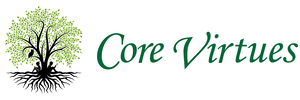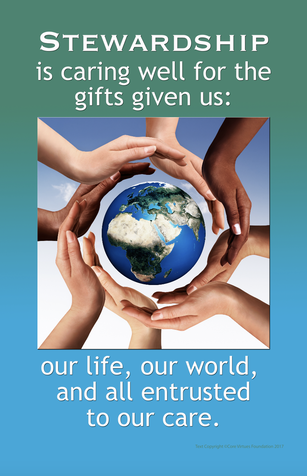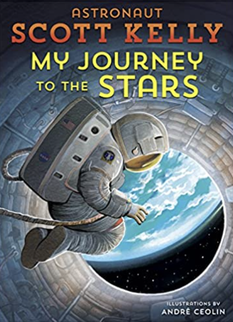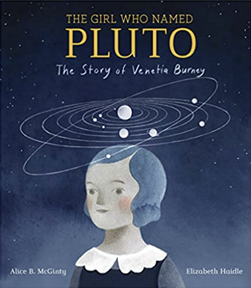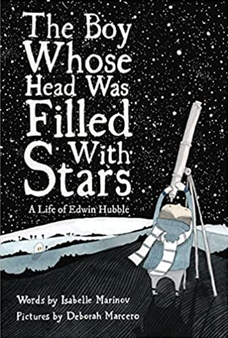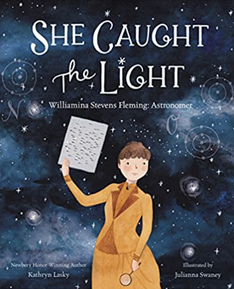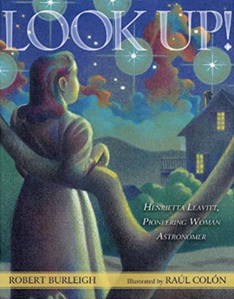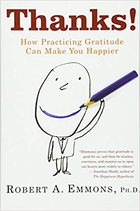We add books daily to our recommendations - visit us often!
November is a time of national thanksgiving. On Veteran's Day (November 11), we remember with gratitude those who have served in our armed forces. But of course, Thanksgiving, the fourth Thursday of the month, is the American holiday—a day to give thanks for our many blessings, among them: the bounty of our land and seas, and the blessing of liberty so many came here to enjoy. It is an occasion to celebrate the ongoing goodness of the world we inhabit.
For many children this celebration is a natural and welcomed exercise—a time to reflect on what they like best about their lives. All too many children, however, grow up in homes and neighborhoods where goodness is not easily visible. To that end, literature can be an important vehicle of hope—an opportunity for us to lift their hearts and thoughts to much of what is positive in the world.
We make gratitude and wonder (an awe-filled appreciation for the beauty and bounty of the world around us) the focus of the November rotation in years 1 and 2. In addition to lifting hearts through literature, children could be encouraged to keep a gratitude journal, jotting down each day three things or moments for which they are grateful. In year 3, we focus on good stewardship of gifts received. We gain literary inspiration from real-life stewards, and many stewards of the earth and the environment are spotlighted below. But children should also be encouraged to reflect on personal stewardship: do I care well for my body? my brothers and sisters? my toys? the home my parents have created for us? our classroom? my classmates? the playground equipment I use? the parks I visit? "If you take care of the small things," Emily Dickinson reminded us, "the big things will take care of themselves."
See our teacher and parent recommendations below for latest grown-up reflections on the importance of gratitude. We feature an excellent video by Brother David Steindl-Rast, along with important work by psychologist Robert Emmons.
November Recommendations
Additional books are recommended in the original Resource Guide.
Red highlighting indicates a book on our Core Book list.
Veterans Day Recommendations can be found in the November Heroes section.
Additional suggestions by virtue for K-3 ; Additional suggestions for 3-6
Additional books are recommended in the original Resource Guide.
Red highlighting indicates a book on our Core Book list.
Veterans Day Recommendations can be found in the November Heroes section.
Additional suggestions by virtue for K-3 ; Additional suggestions for 3-6
New and Noteworthy
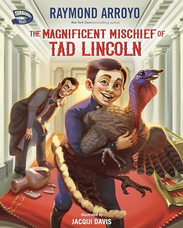
The Magnificent Mischief of Tad Lincoln. Raymond Arroyo. Illustrated by Jacqui Davis. Zonderkidz, 2023. (K-3) Stewardship, Mercy.
President Lincoln exercises stewardship and mercy when his young son Tad befriends the turkey meant for Thanksgiving dinner at the White House. With energetic text and vivacious illustrations, this tale spotlights Lincoln family life in the White House, the tragedy of son Willi's death, and Abe Lincoln's empathy and mercy particularly in the context of the Civil War. Lincoln is shown as a president who believes in the power of a pardon. Includes an annotated list of sources for this true story of the annual Presidential pardoning of the Thanksgiving turkey. Lincoln began the tradition.
President Lincoln exercises stewardship and mercy when his young son Tad befriends the turkey meant for Thanksgiving dinner at the White House. With energetic text and vivacious illustrations, this tale spotlights Lincoln family life in the White House, the tragedy of son Willi's death, and Abe Lincoln's empathy and mercy particularly in the context of the Civil War. Lincoln is shown as a president who believes in the power of a pardon. Includes an annotated list of sources for this true story of the annual Presidential pardoning of the Thanksgiving turkey. Lincoln began the tradition.
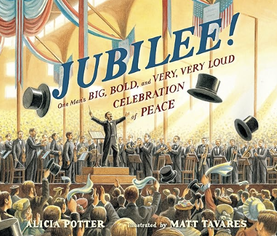
Jubilee!: One Man's Big, Bold, and Very, Very Loud Celebration of Peace. Alicia Potter. Illustrated by Matt Tavares. Candlewick, 2014. (K-3) Joy, Gratitude, Love of Country.
Published in 2014, this book is new to us. Irish American bandmaster Patrick Sarsfield Gilmore came to the US in 1849 and enlisted with the 24th Massachusetts Volunteers in his adopted country's Civil War. When the war ended, grateful for peace and the fruits of liberty, Gilmore wanted to celebrate with the biggest concert the world had ever seen: a Peace Jubilee! This light-hearted and yet weighty tale will astound: the target date is June 15, 1869 and the place is Boston. Can Gilmore bring together 12 cannons, 20,000 singers, 40 church bells, and 1,000 musicians into one glorious sound? An intriguing and little-known story about the composer of "When Johnny Comes Marching Home" and one of America's greatest military musicians. Teachers will need to supply key background on the importance of the Civil War. Surprisingly, the writer and publisher failed to mention that the war ended slavery and inspired this joyful celebration.
Published in 2014, this book is new to us. Irish American bandmaster Patrick Sarsfield Gilmore came to the US in 1849 and enlisted with the 24th Massachusetts Volunteers in his adopted country's Civil War. When the war ended, grateful for peace and the fruits of liberty, Gilmore wanted to celebrate with the biggest concert the world had ever seen: a Peace Jubilee! This light-hearted and yet weighty tale will astound: the target date is June 15, 1869 and the place is Boston. Can Gilmore bring together 12 cannons, 20,000 singers, 40 church bells, and 1,000 musicians into one glorious sound? An intriguing and little-known story about the composer of "When Johnny Comes Marching Home" and one of America's greatest military musicians. Teachers will need to supply key background on the importance of the Civil War. Surprisingly, the writer and publisher failed to mention that the war ended slavery and inspired this joyful celebration.
November Books Spotlight:
Looking Up in Wonder
November, our month for wondering at the natural world, is a great moment to highlight the work of great astronomers, many of them women, who had influence on the study of the planets and stars. We feature three special women in our new books for this month: Venetia Burney, Williamina Stevens Fleming, and Henrietta Leavitt. We also salute Edwin Hubble, for whom the Hubble Space Telescope was named, and feature a first-person account of living in space for a year by astronaut Scott Kelly, who set that endurance record working on the International Space Station. Preview the book covers below, and check out our full-length reviews further down the page! If you'd like to learn more about the work of contemporary astronomers, Harvard professor and astonomer Karin Öberg can enlighten you. She recently gave a TED talk on "the galactic recipe for a living planet."

Bird Girl: Gene Stratton-Porter Shares Her Love of Nature with the World. Jill Esbaum and Rebecca Gibbon. Calkins Creek, 2024 (K-3) Wonder, Stewardship, Lives to Learn From.
Some teachers may know Gene Stratton-Porter best from her fiction and nonfiction books—notable among them A Girl of the Limberlost. Winsome, detailed illustrations help tell a simple yet remarkable story of a girl who loved and befriended birds, then grew up to be a photographer of remarkable birds as well as an author and naturalist whose home was full of birds. More detailed information on her life comes at the end of the book, sure to interest adults and older kids.
Some teachers may know Gene Stratton-Porter best from her fiction and nonfiction books—notable among them A Girl of the Limberlost. Winsome, detailed illustrations help tell a simple yet remarkable story of a girl who loved and befriended birds, then grew up to be a photographer of remarkable birds as well as an author and naturalist whose home was full of birds. More detailed information on her life comes at the end of the book, sure to interest adults and older kids.

Wild Places: The Life of Naturalist David Attenborough. Hayley and John Rocco. Putnam, 2024 (K-2) Wonder, Stewardship, Lives to Learn From.
This lavishly-illustrated book tells the story of naturalist David Attenborough, from his childhood explorations in the woods to his later career forwarding the causes of environmental stewardship. Children will be inspired by Attenborough's adventurous life in jungles, oceans, mountains, and tundra. A fitting tribute to the best-known nature documentarian of our time.
This lavishly-illustrated book tells the story of naturalist David Attenborough, from his childhood explorations in the woods to his later career forwarding the causes of environmental stewardship. Children will be inspired by Attenborough's adventurous life in jungles, oceans, mountains, and tundra. A fitting tribute to the best-known nature documentarian of our time.

The Polio Pioneer: Dr. Jonas Salk and the Polio Vaccine. Linda Elovitz Marshall. Illustrated by Lisa Anchin. Knopf Books for Young Readers, 2020. (K-3) Imagination, Diligence
Jonas Salk grows up in a devout Jewish family, and notices things most other kids don’t—particularly, the needs of people in pain. He becomes a doctor and the suffering of soldiers returning from World War II makes him want to alleviate pain. His first remarkable work, being the co-inventor of the first flu vaccine, is followed by an even more important discovery: the invention of a polio vaccine. Polio regularly crippled young children in the forties and fifties, and his work put an end to that. A colorfully-illustrated narrative that describes the history of the polio vaccine in enough detail to be interesting, but not so much that it will be bewildering to young readers.
Jonas Salk grows up in a devout Jewish family, and notices things most other kids don’t—particularly, the needs of people in pain. He becomes a doctor and the suffering of soldiers returning from World War II makes him want to alleviate pain. His first remarkable work, being the co-inventor of the first flu vaccine, is followed by an even more important discovery: the invention of a polio vaccine. Polio regularly crippled young children in the forties and fifties, and his work put an end to that. A colorfully-illustrated narrative that describes the history of the polio vaccine in enough detail to be interesting, but not so much that it will be bewildering to young readers.

Mirandy and Brother Wind. Patricia McKissack. Illustrated by Jerry Pinkney. Dragonfly Books, 1997. (K-2) Wonder, Friendship.
Young Mirandy is going to the junior cakewalk jubilee, and she has the perfect partner in mind: the mysterious Brother Wind. So she sets out on a journey to capture the wind, with family and friends offering advice, strategies, or skepticism along the way. Eventually, she triumphs, but to her own surprise, she finds that her friend Ezel is the person she really wants to dance with. Illustrated fancifully by the master Jerry Pinkney.
Young Mirandy is going to the junior cakewalk jubilee, and she has the perfect partner in mind: the mysterious Brother Wind. So she sets out on a journey to capture the wind, with family and friends offering advice, strategies, or skepticism along the way. Eventually, she triumphs, but to her own surprise, she finds that her friend Ezel is the person she really wants to dance with. Illustrated fancifully by the master Jerry Pinkney.

Joan Procter, Dragon Doctor. Patricia Valdez. Illustrated by Felicita Sala. Knopf Books for Young Readers, 2018. (K-3) Wonder, Stewardship.
Vivid, artistic illustrations accompany the story of a very unusual life. Growing up in early 20th century London, young Joan was fascinated by reptiles—at age 16, she could be seen walking her pet crocodile down the street. When she grew up, she became the first female curator at the London Zoo’s Reptile House, and did important work introducing people to these often feared and misunderstood animals, particularly komodo dragons. Engagingly told.
Vivid, artistic illustrations accompany the story of a very unusual life. Growing up in early 20th century London, young Joan was fascinated by reptiles—at age 16, she could be seen walking her pet crocodile down the street. When she grew up, she became the first female curator at the London Zoo’s Reptile House, and did important work introducing people to these often feared and misunderstood animals, particularly komodo dragons. Engagingly told.
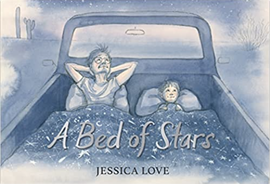
A Bed of Stars. Jessica Love. Candlewick Press, 2023. (K-2) Wonder, Stewardship, Friendship.
A young boy feels fearful when he is going to bed, because the universe feels endlessly big. His father takes him on a camping trip into the desert, along the way telling him about the plants, animals, and stars that they encounter on their journey. At the end, the little boy falls asleep in his own room feeling comforted: "above me and below me and all around me are all my friends and family." Notable depictions of stewardship (they leave their campsite nice and neat!) and of strong, healthy family bonding. An unusually-told story with lovely illustrations.
A young boy feels fearful when he is going to bed, because the universe feels endlessly big. His father takes him on a camping trip into the desert, along the way telling him about the plants, animals, and stars that they encounter on their journey. At the end, the little boy falls asleep in his own room feeling comforted: "above me and below me and all around me are all my friends and family." Notable depictions of stewardship (they leave their campsite nice and neat!) and of strong, healthy family bonding. An unusually-told story with lovely illustrations.
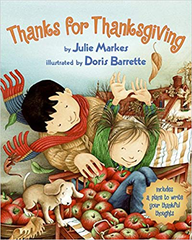
Thanks for Thanksgiving. Julie Markes. Illustrated by Doris Barrette. Harper Collins, 2004. (Pre-K-1) Gratitude
For the very young, this is a charming, vividly illustrated picture book, in which a brother and sister count their blessings. The text is modest, but sweetly rhyming. “Thanks for Thanksgiving, for turkey and pie. Thank you for fall and gold leaves floating by… Thanks for umbrellas, for rain boots and puddles. Thank you for Mommy and warm, cozy cuddles.” The text will encourage young children to reflect on what they're thankful for, and maybe even rhyme their blessings.
For the very young, this is a charming, vividly illustrated picture book, in which a brother and sister count their blessings. The text is modest, but sweetly rhyming. “Thanks for Thanksgiving, for turkey and pie. Thank you for fall and gold leaves floating by… Thanks for umbrellas, for rain boots and puddles. Thank you for Mommy and warm, cozy cuddles.” The text will encourage young children to reflect on what they're thankful for, and maybe even rhyme their blessings.
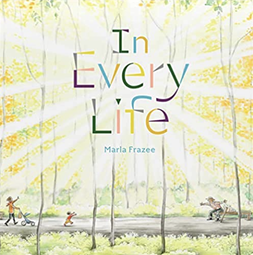
In Every Life. Marla Frazee. Beach Lane Books, 2023. Gratitude, Wonder, Hope, Joy, Schools of Faith. (K-1)
Inspired by a traditional Jewish baby-naming blessing, this simple book is a sweetly-illustrated and wondrous tour through the beautiful moments of being human. From the happy to the sad to the poignant, illustrations of people of all ages and all races experiencing moments of life accompany beautiful phrases that will stick with the reader long after the book is closed—"In every moment, blessed is the mystery. In every sadness, blessed is the comfort. In every love, blessed are the tears." This is a book for very young children, but even adults will take something meaningful from it.
Inspired by a traditional Jewish baby-naming blessing, this simple book is a sweetly-illustrated and wondrous tour through the beautiful moments of being human. From the happy to the sad to the poignant, illustrations of people of all ages and all races experiencing moments of life accompany beautiful phrases that will stick with the reader long after the book is closed—"In every moment, blessed is the mystery. In every sadness, blessed is the comfort. In every love, blessed are the tears." This is a book for very young children, but even adults will take something meaningful from it.
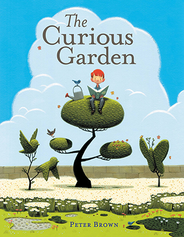
The Curious Garden. Peter Brown. Little, Brown, 2009. (K-2) Stewardship
Young Liam lives in a drab, gray city, but spots life near the railroad tracks and comes daily to tend the plants he’s discovered. Marvelous things follow. An “ecological fable of urban renewal”? Yes, and it’s lovely. Simple, quietly surreal paintings.
Young Liam lives in a drab, gray city, but spots life near the railroad tracks and comes daily to tend the plants he’s discovered. Marvelous things follow. An “ecological fable of urban renewal”? Yes, and it’s lovely. Simple, quietly surreal paintings.
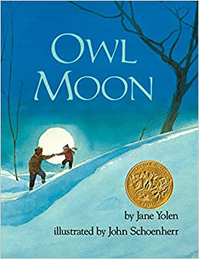
Owl Moon. Jane Yolen. Illustrated by John Schoenherr. Putnam Publishing Group, 1987. (K-2) Wonder
On a cold, clear, moonlit night, a young boy is finally old enough to go "owling" with his dad. Father and son embark on a midnight watch. Awe, beauty, and respect for nature combine with the special bond of father and son.
On a cold, clear, moonlit night, a young boy is finally old enough to go "owling" with his dad. Father and son embark on a midnight watch. Awe, beauty, and respect for nature combine with the special bond of father and son.
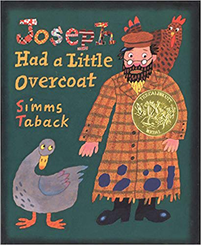
Joseph Had A Little Overcoat. Simms Taback.
Viking, 1999. (K-2) Stewardship
Based on a Yiddish folk song, this is the tale of how Joseph resourcefully uses every bit of his worn, torn overcoat to make something out of nothing. In our modern world, where used things are often just thrown away, this concept of re-purposing might be eye-opening. Bright, detailed, cartoonish illustrations with die-cut shapes indicate what will happen to the coat next. Music and lyrics for the song are included at the back of the book.
Viking, 1999. (K-2) Stewardship
Based on a Yiddish folk song, this is the tale of how Joseph resourcefully uses every bit of his worn, torn overcoat to make something out of nothing. In our modern world, where used things are often just thrown away, this concept of re-purposing might be eye-opening. Bright, detailed, cartoonish illustrations with die-cut shapes indicate what will happen to the coat next. Music and lyrics for the song are included at the back of the book.
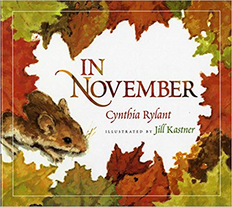
In November. Cynthia Rylant.
Illustrated by Jill Kastner. HMH Books, 2008. (K-2) Wonder
Whether you are focusing on gratitude, stewardship, or wonder, this gentle reflection on seasonal change in the month of November grounds and moves students. A lyrical reflection on the month of abundance, harvest, and preparation for winter at a time of Thanksgiving. Marvelous illustrations.
Illustrated by Jill Kastner. HMH Books, 2008. (K-2) Wonder
Whether you are focusing on gratitude, stewardship, or wonder, this gentle reflection on seasonal change in the month of November grounds and moves students. A lyrical reflection on the month of abundance, harvest, and preparation for winter at a time of Thanksgiving. Marvelous illustrations.
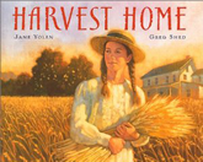
Harvest Home. Jane Yolen.
Illustrated by Greg Shed. Harcourt, 2002. (K-2) Gratitude
Written in verse with the rhythmic repetition of “bringing the harvest home,” this is simple and lyrical celebration of a bountiful fall harvest. The poetry recounts the work it took to make it happen, as well as the joys of reaping its rewards. Our guide is a young girl with honey colored hair and a yellow straw hat, who leads children through the work and joy of gathering in the harvest on a fall afternoon. Greg Shed works visual wonders with golden hues of wheat and sun-baked afternoons suffusing its pages.
Illustrated by Greg Shed. Harcourt, 2002. (K-2) Gratitude
Written in verse with the rhythmic repetition of “bringing the harvest home,” this is simple and lyrical celebration of a bountiful fall harvest. The poetry recounts the work it took to make it happen, as well as the joys of reaping its rewards. Our guide is a young girl with honey colored hair and a yellow straw hat, who leads children through the work and joy of gathering in the harvest on a fall afternoon. Greg Shed works visual wonders with golden hues of wheat and sun-baked afternoons suffusing its pages.
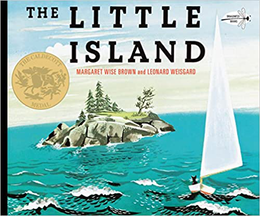
The Little Island. Margaret Wise Brown. Illustrated by Leonard Weisgard. Doubleday, 2003. (K-2) Stewardship, Wonder, Gratitude
This lyrical, calming tale feels like a 10 minute vacation. Margaret Wise Brown's poetic gift meets Leonard Weisgard's unerring brush. There is something so enchanting about an island – difficult to reach, wondrous in its tides, and breezes, and changing seasons. Blessed in its lobsters, gulls, and seals. And wait ... in its cat? Yes, a kitten sails to the island's rocky shores and explores it. Young readers will delight in her adventures. She learns “the island is a part of the world and a world of its own surrounded by the bright blue sea." If this sounds like an event-free bonanza of a book, it is -- for young and old alike.
This lyrical, calming tale feels like a 10 minute vacation. Margaret Wise Brown's poetic gift meets Leonard Weisgard's unerring brush. There is something so enchanting about an island – difficult to reach, wondrous in its tides, and breezes, and changing seasons. Blessed in its lobsters, gulls, and seals. And wait ... in its cat? Yes, a kitten sails to the island's rocky shores and explores it. Young readers will delight in her adventures. She learns “the island is a part of the world and a world of its own surrounded by the bright blue sea." If this sounds like an event-free bonanza of a book, it is -- for young and old alike.
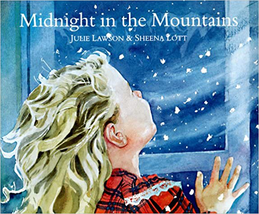
Midnight in the Mountains.* Julie Lawson. Illustrated by Sheena Lott
Orca Book Publishers, 1998 (K-2) Wonder
Lilting text and delightful watercolors convey the wonder of a young girl, who experiences a winter vacation in the mountains with her family. She delights in snow, vistas, and stillness of nature, the wonder of this special time and place.
*Available on Epic!
Orca Book Publishers, 1998 (K-2) Wonder
Lilting text and delightful watercolors convey the wonder of a young girl, who experiences a winter vacation in the mountains with her family. She delights in snow, vistas, and stillness of nature, the wonder of this special time and place.
*Available on Epic!
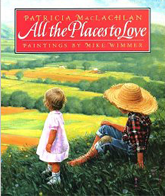
All the Places to Love. Patricia MacLachlan.
Illustrated by Mike Wimmer. Harper Collins, 1994. (K-2) Gratitude, Wonder
On the day he was born, grandma held Eli up to the window “so that what I heard first was the wind. What I saw first were all the places to love: the valley, the river falling down over rocks, the hilltop where the blueberries grew.” In this beautiful tale, we follow Eli and his family through meadows, hayfields, rocks and rivers, as he learns about all the places to love and imagines sharing them with his newborn sister. With its lyrical phrasing and lush vistas, this book instills wonder and evokes gratitude for the world around us.
Illustrated by Mike Wimmer. Harper Collins, 1994. (K-2) Gratitude, Wonder
On the day he was born, grandma held Eli up to the window “so that what I heard first was the wind. What I saw first were all the places to love: the valley, the river falling down over rocks, the hilltop where the blueberries grew.” In this beautiful tale, we follow Eli and his family through meadows, hayfields, rocks and rivers, as he learns about all the places to love and imagines sharing them with his newborn sister. With its lyrical phrasing and lush vistas, this book instills wonder and evokes gratitude for the world around us.
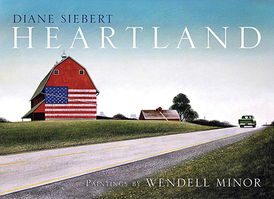
Siebert, Diane. Heartland. Illustrated by Wendell C. Minor. David Godine, 2015. (K-2) Wonder
This stunning picture book recreates the American landscape with poetic and narrative beauty. The descriptions of key areas in the United States inspire wonder and love.
This stunning picture book recreates the American landscape with poetic and narrative beauty. The descriptions of key areas in the United States inspire wonder and love.
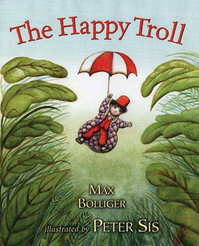
The Happy Troll. Max Bollinger.
Illustrated by Peter Sis. Henry Holt, 2005. (K-2) Stewardship
Gus, an ordinary troll with an extraordinary voice, sings to the delight all his forest friends. They cheerfully supply his modest needs to hear him sing, but one day Gus decides his happiness will not be complete until he acquires the gold ring of a raven, the gold crown of snake, and the gold carriage of a frog. He wins those, but in the process loses his voice and his happiness. When he realizes he can no longer find his songs, he changes course. A short, whimsically illustrated tale reminding us that happiness comes not from things, but from careful stewardship of our gifts—using them to benefit others.
Illustrated by Peter Sis. Henry Holt, 2005. (K-2) Stewardship
Gus, an ordinary troll with an extraordinary voice, sings to the delight all his forest friends. They cheerfully supply his modest needs to hear him sing, but one day Gus decides his happiness will not be complete until he acquires the gold ring of a raven, the gold crown of snake, and the gold carriage of a frog. He wins those, but in the process loses his voice and his happiness. When he realizes he can no longer find his songs, he changes course. A short, whimsically illustrated tale reminding us that happiness comes not from things, but from careful stewardship of our gifts—using them to benefit others.
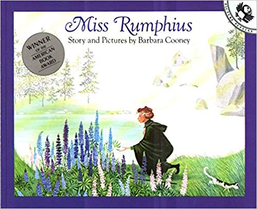
Miss Rumphius. Barbara Cooney.
Puffin, 1985 (K-2) Wonder, Stewardship
This marvelous book is still in print! Residing on a seaside cliff, elderly Miss Rumphius is something of a enigma to neighborhood children. When they visit, they hear her story of a life well lived, and of a woman intent on giving something back to the world. The mystery and beauty of life are joined with determination to do one’s part. Miss Rumphius’ lupines are living proof of her love.
Puffin, 1985 (K-2) Wonder, Stewardship
This marvelous book is still in print! Residing on a seaside cliff, elderly Miss Rumphius is something of a enigma to neighborhood children. When they visit, they hear her story of a life well lived, and of a woman intent on giving something back to the world. The mystery and beauty of life are joined with determination to do one’s part. Miss Rumphius’ lupines are living proof of her love.
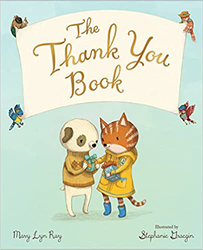
The Thank You Book. Mary Lyn Ray. Illustrated by Stephanie Graegin. HMH Books for Young Readers, 2018. (K-2) Gratitude, Wonder
Another charming book from this perfect duo of author and illustrator. "Thank you," Ray stresses, is not just for manners. It's "when something wakes a little hum-a happy little hum- inside you and you want to answer back." Coinciding perfectly with modern research on the importance of gratitude, this is a perfectly illustrated book that shows children and animal friends enjoying each other and feeling gratitude for "all that makes us wonder."
Another charming book from this perfect duo of author and illustrator. "Thank you," Ray stresses, is not just for manners. It's "when something wakes a little hum-a happy little hum- inside you and you want to answer back." Coinciding perfectly with modern research on the importance of gratitude, this is a perfectly illustrated book that shows children and animal friends enjoying each other and feeling gratitude for "all that makes us wonder."
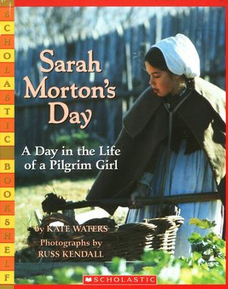
Sarah Morton’s Day: A Day in the Life of a Pilgrim Girl. Kate Waters
Photographs by Russ Kendall. Scholastic, 2008. (K-2) Gratitude, Stewardship
Sarah Morton was a real pilgrim child. This is a lovely day-in-the-life book photographed at the historical re-creation of Plymouth Plantation in Massachusetts. There interpreters dress in costume, and behave as original inhabitants. Modeling thankfulness for the many (if modest) gifts in her life, Sarah Morton will be an inspiration to modern six year olds!
Photographs by Russ Kendall. Scholastic, 2008. (K-2) Gratitude, Stewardship
Sarah Morton was a real pilgrim child. This is a lovely day-in-the-life book photographed at the historical re-creation of Plymouth Plantation in Massachusetts. There interpreters dress in costume, and behave as original inhabitants. Modeling thankfulness for the many (if modest) gifts in her life, Sarah Morton will be an inspiration to modern six year olds!
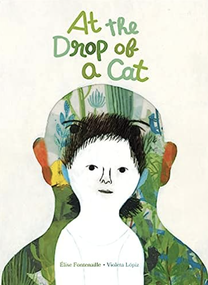
At the Drop of a Cat. Elise Fontenaille. Illustrated by Violeta Lopiz. Translated by Karin Snelson. Enchanted Lion Books, 2023. Wonder, Wisdom (K-3)
A six-year-old spends rich time with his grandfather Luis, whose garden reaches to the sky and whose imagination soars higher. Luis was a refugee from war (in Spain), and has never gone to school, but he has worked as a cook and gardener. He has the wisdom of those who have nurtured life -- and a playful vocabulary with many idioms that express truth. At the drop of a cat means very quickly and without warning. Rich humor combine with insights into suffering in his past. Themes of intergenerational love, as well as wonder and wisdom.
A six-year-old spends rich time with his grandfather Luis, whose garden reaches to the sky and whose imagination soars higher. Luis was a refugee from war (in Spain), and has never gone to school, but he has worked as a cook and gardener. He has the wisdom of those who have nurtured life -- and a playful vocabulary with many idioms that express truth. At the drop of a cat means very quickly and without warning. Rich humor combine with insights into suffering in his past. Themes of intergenerational love, as well as wonder and wisdom.
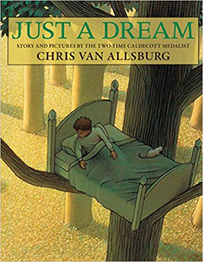
Just A Dream. Chris Van Allsburg. Houghton Mifflin, 2011. (K-3)Stewardship
Young Walter is a careless, self-centered kid who doesn’t see why he should waste his time recycling, and can’t understand why anyone would want to plant or water a tree. He dreams of a future when chores are done for him. In intriguing pictures, his dream of the future turns out to be a catastrophic nightmare. When he awakens, he finds his attitude toward the world around him is changed too. A great “Earth Day” choice for April.
Young Walter is a careless, self-centered kid who doesn’t see why he should waste his time recycling, and can’t understand why anyone would want to plant or water a tree. He dreams of a future when chores are done for him. In intriguing pictures, his dream of the future turns out to be a catastrophic nightmare. When he awakens, he finds his attitude toward the world around him is changed too. A great “Earth Day” choice for April.
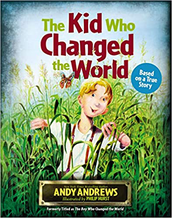
The Kid Who Changed the World. Andy Andrews. Thomas Nelson, 2014. Wonder, Stewardship, Diligence (K-3)
This is the true story of plant scientist Norman Borlaug, who grew up on an Iowa farm surrounded by corn and plenty, but knew that many people in the world were starving. How could he make a difference and alleviate hunger? Borlaug learned everything he could about plants, and came up with new strains that yielded three harvests per year, and saved billions from starvation. He was mentored by fellow Iowan and Vice President Henry Wallace, who in turn had been mentored by George Washington Carver (our hero this month), who in turn had been tutored by Susan Carver. This is a brightly illustrated book with a bright message: knowledge is passed on in a great chain, for which we should be grateful. Each new kernel of understanding builds on the previous. And a diligent kid can change the world. (See our profile of Borlaug here.)
This is the true story of plant scientist Norman Borlaug, who grew up on an Iowa farm surrounded by corn and plenty, but knew that many people in the world were starving. How could he make a difference and alleviate hunger? Borlaug learned everything he could about plants, and came up with new strains that yielded three harvests per year, and saved billions from starvation. He was mentored by fellow Iowan and Vice President Henry Wallace, who in turn had been mentored by George Washington Carver (our hero this month), who in turn had been tutored by Susan Carver. This is a brightly illustrated book with a bright message: knowledge is passed on in a great chain, for which we should be grateful. Each new kernel of understanding builds on the previous. And a diligent kid can change the world. (See our profile of Borlaug here.)
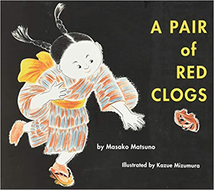
A Pair of Red Clogs. Masako Matsuno. Illustrated by Kazue Mizumura. Purple House Press, 2019. (K-3) Honesty, Stewardship
A young Japanese girl is smitten with her new red lacquer clogs. While she is playing a game, one of the clogs cracks. Now it is not-so-new and not-so-special. She comes up with a plan to trick her mother into buying her a new pair of clogs, but in the end is too ashamed to lie to her mother about what happened (spoiler alert: her mother knows!). A charming story rich in Japanese culture (works well with Core Knowledge units on Japan in first and fourth grades.)
A young Japanese girl is smitten with her new red lacquer clogs. While she is playing a game, one of the clogs cracks. Now it is not-so-new and not-so-special. She comes up with a plan to trick her mother into buying her a new pair of clogs, but in the end is too ashamed to lie to her mother about what happened (spoiler alert: her mother knows!). A charming story rich in Japanese culture (works well with Core Knowledge units on Japan in first and fourth grades.)
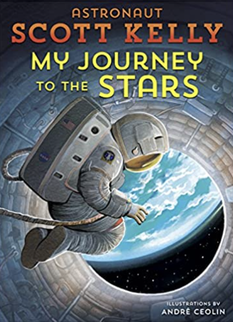
My Journey to the Stars. Scott Kelly. Illustrated by Andre Ceolin. Crown Books for Young Readers, 2017. Wonder, Perseverance, K-3
Astronaut Scott Kelly penned this account of his one year stay in the International Space Station for young children. It's a great book for antsy students, whose first pass at scholarship is not smooth. Kelly had such a background. He is an identical twin, and both he and his brother Mark longed to be astronauts and realized that dream. But Scott's career led him to this one year test of endurance in space with two Russian colleagues. Lively illustrations commingle with photos and text to inspire future space travelers.
Astronaut Scott Kelly penned this account of his one year stay in the International Space Station for young children. It's a great book for antsy students, whose first pass at scholarship is not smooth. Kelly had such a background. He is an identical twin, and both he and his brother Mark longed to be astronauts and realized that dream. But Scott's career led him to this one year test of endurance in space with two Russian colleagues. Lively illustrations commingle with photos and text to inspire future space travelers.
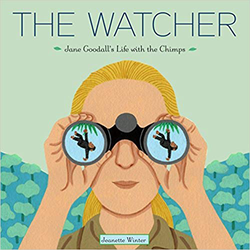
The Watcher. Jane Goodall’s Life With the Chimps. Jeanette Winter. Schwartz Wade Books, 2011. (K-3) Lives to Learn From, Diligence, Stewardship, Courage, Hope
A simple biography of Jane Goodall’s amazing life with her beloved chimps. A quiet and keen observer from an early age, Jane loved animals and knew that she wanted to study them in the wild. She worked hard to make that happen, eventually moving from London to the Gombe forest in Tanzania to study chimpanzees. The chimps became accustomed to "the white ape" among them (the phrase is Jane's self-description). Goodall spent many years studying the primates, writing about them, and educating the world about their habits. When deforestation threatened the forests in which they lived, Jane realized she could be a voice for the chimps. At age 85, she continues to educate many about protecting animals, their habitat, and the planet.
A simple biography of Jane Goodall’s amazing life with her beloved chimps. A quiet and keen observer from an early age, Jane loved animals and knew that she wanted to study them in the wild. She worked hard to make that happen, eventually moving from London to the Gombe forest in Tanzania to study chimpanzees. The chimps became accustomed to "the white ape" among them (the phrase is Jane's self-description). Goodall spent many years studying the primates, writing about them, and educating the world about their habits. When deforestation threatened the forests in which they lived, Jane realized she could be a voice for the chimps. At age 85, she continues to educate many about protecting animals, their habitat, and the planet.
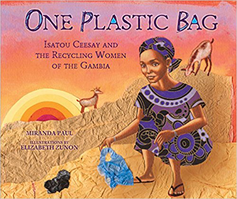
One Plastic Bag: Isatou Ceesay and the Recycling Women of the Gambia. Paul Miranda. Illustrated by Elizabeth Zunon. Milbrook Press, 2015. (K-3) Stewardship
Accustomed to dropping worn and useless (biodegradable) woven bags on the ground, the people of Gambia did the same with new plastic bags, but on the roadside this new plastic litter pooled water, attracting mosquitoes (disease), and when goats feasted on them, they choked. A young girl, Isatou Ceesay, found a way to make good use of these bags, enlist her compatriots, and clean up Gambia’s roads. A splendid lesson in stewardship of the world’s resources and care for the environment. Lyrical text and vivid, dramatic illustrations.
Accustomed to dropping worn and useless (biodegradable) woven bags on the ground, the people of Gambia did the same with new plastic bags, but on the roadside this new plastic litter pooled water, attracting mosquitoes (disease), and when goats feasted on them, they choked. A young girl, Isatou Ceesay, found a way to make good use of these bags, enlist her compatriots, and clean up Gambia’s roads. A splendid lesson in stewardship of the world’s resources and care for the environment. Lyrical text and vivid, dramatic illustrations.
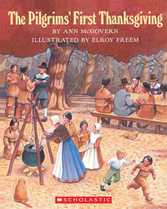
The Pilgrim’s First Thanksgiving. Ann McGovern.
Illustrated by Elroy Freem. Scholastic, 1993. (K-3) Gratitude
In print for twenty-five years, this little volume recounts the story of the Pilgrims with verve and sympathy. McGovern’s language is concrete and evocative: “The Mayflower was as big as two trucks.” She recounts the difficulty of the voyage, the hardship of the first winter in Plymouth, the community’s quest to build homes and establish gardens, and the Native Americans, who helped them (with special focus on Squanto, of course). Beautiful illustrations by Freem are reminiscent of N.C. Wyeth.
Illustrated by Elroy Freem. Scholastic, 1993. (K-3) Gratitude
In print for twenty-five years, this little volume recounts the story of the Pilgrims with verve and sympathy. McGovern’s language is concrete and evocative: “The Mayflower was as big as two trucks.” She recounts the difficulty of the voyage, the hardship of the first winter in Plymouth, the community’s quest to build homes and establish gardens, and the Native Americans, who helped them (with special focus on Squanto, of course). Beautiful illustrations by Freem are reminiscent of N.C. Wyeth.
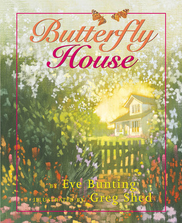
Butterfly House. Eve Bunting. Illustrated by Greg Shed. Scholastic Press, 1999. (K-3) Wonder, Stewardship.
Beautiful illustrations bring to life this story of a little girl attempting to save a larva from being eaten by a jay. She and her grandfather build a safe place where the larva can make its chrysalis and begin to turn into a butterfly. The relationship of the grandfather and the child is quite touching. The girl is rewarded for her care of the butterfly with generations of butterflies enjoying her gardens.
Beautiful illustrations bring to life this story of a little girl attempting to save a larva from being eaten by a jay. She and her grandfather build a safe place where the larva can make its chrysalis and begin to turn into a butterfly. The relationship of the grandfather and the child is quite touching. The girl is rewarded for her care of the butterfly with generations of butterflies enjoying her gardens.
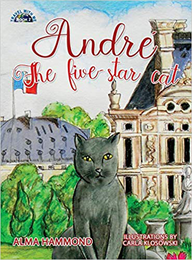
Andre the Five Star Cat. Alma Hammond. Illustrated by Carla Klosowski. SweetBeet Books, 2017. (K-3) Gratitude, Friendship,
Set in Paris, this is the story of a spoiled cat, who is forced outside the luxurious lair she has hitherto taken for granted. She makes new friends who are very much out of her comfort zone and comes to appreciate the many blessings of her life. (Also a marvelous child's introduction to Paris.)
Set in Paris, this is the story of a spoiled cat, who is forced outside the luxurious lair she has hitherto taken for granted. She makes new friends who are very much out of her comfort zone and comes to appreciate the many blessings of her life. (Also a marvelous child's introduction to Paris.)
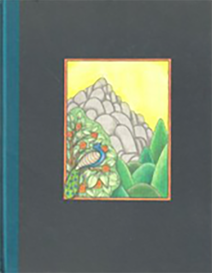
The Stonecutter: An Indian Folktale. Patricia Newton
Putnam Juvenile, 1990. (K-3) Gratitude
Set in ancient India, this folktale recounts the restlessness of a poor stonecutter, who wishes for a different life. Through the aegis of the Mountain Spirit, the stonecutter becomes a wealthy merchant, a king, the wind, and even the sun, but comes to realize that he is actually happiest as a humble stonecutter. At book’s end, he learns to be grateful for the life and gifts he has. Stunning pastels rendered in the tradition of Indian art, this is an excellent complement to the Core Knowledge grade 2, Ancient India unit.
Putnam Juvenile, 1990. (K-3) Gratitude
Set in ancient India, this folktale recounts the restlessness of a poor stonecutter, who wishes for a different life. Through the aegis of the Mountain Spirit, the stonecutter becomes a wealthy merchant, a king, the wind, and even the sun, but comes to realize that he is actually happiest as a humble stonecutter. At book’s end, he learns to be grateful for the life and gifts he has. Stunning pastels rendered in the tradition of Indian art, this is an excellent complement to the Core Knowledge grade 2, Ancient India unit.
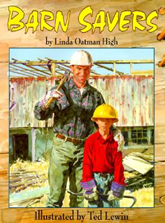
Barn Savers. Linda Oatman High.
Illustrated by Ted Lewin. Boyds Mills, 1999 (K-3) Gratitude, Stewardship
A young boy and his father rise at dawn to dismantle an old barn before bulldozers can destroy it. They work steadily through the day, the boy stacking wood and the father carefully removing its timbers for new uses. Their stewardship of this simple treasure speaks of respect for the dignity of the structure, for past labors, and for the many new uses the old timbers may have. A particularly good complement for the second grade Core Virtues theme of stewardship of the earth and its resources.
Illustrated by Ted Lewin. Boyds Mills, 1999 (K-3) Gratitude, Stewardship
A young boy and his father rise at dawn to dismantle an old barn before bulldozers can destroy it. They work steadily through the day, the boy stacking wood and the father carefully removing its timbers for new uses. Their stewardship of this simple treasure speaks of respect for the dignity of the structure, for past labors, and for the many new uses the old timbers may have. A particularly good complement for the second grade Core Virtues theme of stewardship of the earth and its resources.
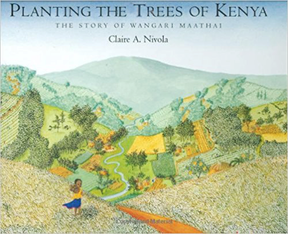
Planting the Trees of Kenya: The Story of Wangari Maathai.
Claire Nivola. Frances Foster Books, 2008. (K-3) Stewardship
A beautifully illustrated and inspiring biography of 2004 Nobel Prize winner Wangari Maathai, who led Kenya’s “Green Belt” movement. Born and raised in the hills of central Kenya, Wangari treasured the richness and beauty of her land. She went off to study biology in the United States (in 1960) and seven years later returned to her homeland to find it largely deforested. Maathai led a movement of Kenyan women to replant trees and restore not simply the stripped land, but the relationship between the land and its people. She was fabulously successful, and was awarded the Nobel Prize for her efforts. This is a stunning book about a woman determined to make the world better place – one tree and one woman at a time.
Claire Nivola. Frances Foster Books, 2008. (K-3) Stewardship
A beautifully illustrated and inspiring biography of 2004 Nobel Prize winner Wangari Maathai, who led Kenya’s “Green Belt” movement. Born and raised in the hills of central Kenya, Wangari treasured the richness and beauty of her land. She went off to study biology in the United States (in 1960) and seven years later returned to her homeland to find it largely deforested. Maathai led a movement of Kenyan women to replant trees and restore not simply the stripped land, but the relationship between the land and its people. She was fabulously successful, and was awarded the Nobel Prize for her efforts. This is a stunning book about a woman determined to make the world better place – one tree and one woman at a time.
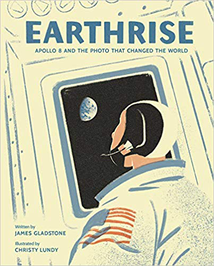
Earthrise: Apollo 8 and the Photo that Changed the World.* James Gladstone. Illustrated by Christy Lundy. Owlkids Books, 2018 (K-3) Wonder, Gratitude, Stewardship
Children raised in a digital age can scarcely conceive of a time when we did not know what our planet looked like from space. The Apollo 8 lunar landing (1969) was a milestone, and this first picture of the earth rising above the surface of the moon struck a chord worldwide. People saw the world without borders; struck by its beauty, they launched a new movement to care for the earth. An important moment to remember even 50 years later. *Available on Epic!
Children raised in a digital age can scarcely conceive of a time when we did not know what our planet looked like from space. The Apollo 8 lunar landing (1969) was a milestone, and this first picture of the earth rising above the surface of the moon struck a chord worldwide. People saw the world without borders; struck by its beauty, they launched a new movement to care for the earth. An important moment to remember even 50 years later. *Available on Epic!
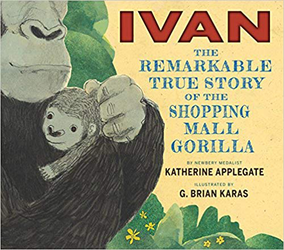
Ivan. The Remarkable True Story of the Shopping Mall Gorilla.* Katherine Applegate. Illustrated by G. Brian Karas. Clarion Books, 2014. (K-3) Stewardship, Compassion, Responsibility
This is the true story of Ivan, a silverback gorilla who was captured in the Congo as a baby (early 1960s). He was sold to a shopping mall pet store in Tacoma, Washington. There he lived alone in a large steel cage for 27 years. People who visited him were moved by his plight – a magnificent, but sulking gorilla, who watched television and sometimes finger-painted. They protested, wrote letters, and petitions. Finally, a new home was found for Ivan at the Atlanta Zoo, where the 1.5 acre gorilla enclosure approximated his natural habitat and Ivan was introduced to more gorillas. He lived to be fifty-years-old, was close to his care-takers, and seemed to be happy. *Available on Epic!
This is the true story of Ivan, a silverback gorilla who was captured in the Congo as a baby (early 1960s). He was sold to a shopping mall pet store in Tacoma, Washington. There he lived alone in a large steel cage for 27 years. People who visited him were moved by his plight – a magnificent, but sulking gorilla, who watched television and sometimes finger-painted. They protested, wrote letters, and petitions. Finally, a new home was found for Ivan at the Atlanta Zoo, where the 1.5 acre gorilla enclosure approximated his natural habitat and Ivan was introduced to more gorillas. He lived to be fifty-years-old, was close to his care-takers, and seemed to be happy. *Available on Epic!
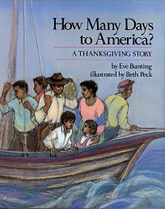
How Many Days to America? A Thanksgiving Story. Eve Bunting.
Illustrated by Beth Peck. Sandpiper, 1990. (K-3) Gratitude
Seeking the blessings of liberty, eager immigrants from an unnamed Caribbean nation set sail on a perilous journey to the United States. They face heavy seas, a leaky vessel, thieves, sickness and hunger, but land in their new home on Thanksgiving Day, and find they have much to be thankful for indeed. Eve Bunting’s touching account is a classic immigrant story and resonates with all whose ancestors left a familiar world in search of a better life. Still in print after twenty years!
Illustrated by Beth Peck. Sandpiper, 1990. (K-3) Gratitude
Seeking the blessings of liberty, eager immigrants from an unnamed Caribbean nation set sail on a perilous journey to the United States. They face heavy seas, a leaky vessel, thieves, sickness and hunger, but land in their new home on Thanksgiving Day, and find they have much to be thankful for indeed. Eve Bunting’s touching account is a classic immigrant story and resonates with all whose ancestors left a familiar world in search of a better life. Still in print after twenty years!
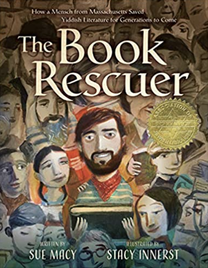
The Book Rescuer. Sue Macy. Illustrated by Stacy Innerst. Simon and Schuster, 2019. (K-3)
Perseverance, Stewardship, Schools of Faith
Aaron’s grandmother traveled alone from Europe to New York to make a new life, but when she got there, she was met by her brother, who took her suitcase with her precious Yiddish books and threw it into the river! He wanted to break with the past. Many years later, Aaron loved books and he wanted to read books about Jews, so he learned Yiddish. When he discovered Yiddish books were hard to find, he began his mission of saving them. Aaron thought of Yiddish books as the “portable homeland“ of the Jewish people. Eventually he built a library with over a million and a half Yiddish books. This is a true story, with good source notes at the end.
Perseverance, Stewardship, Schools of Faith
Aaron’s grandmother traveled alone from Europe to New York to make a new life, but when she got there, she was met by her brother, who took her suitcase with her precious Yiddish books and threw it into the river! He wanted to break with the past. Many years later, Aaron loved books and he wanted to read books about Jews, so he learned Yiddish. When he discovered Yiddish books were hard to find, he began his mission of saving them. Aaron thought of Yiddish books as the “portable homeland“ of the Jewish people. Eventually he built a library with over a million and a half Yiddish books. This is a true story, with good source notes at the end.
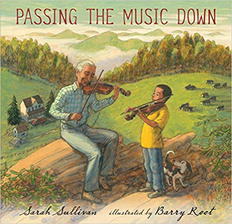
Passing The Music Down. Sarah Sullivan. Illustrated by Barry Root. Candlewick, 2011. (K-3) Gratitude, Love of Country
A fiddle sounds over the hills of Appalachia, and a young boy sets off to learn the art from an elder whose fiddling he admires. They become fast friends and in this lyrical tale one generation imparts lessons to the next, and the young man cares for the elder at the close of his life. Then the young fiddler teaches his music to the next generation. Inspired by the lives of Melvin Wine and Jack Krack, this is a lovely tribute to music of the hill country and the ties that bind.
A fiddle sounds over the hills of Appalachia, and a young boy sets off to learn the art from an elder whose fiddling he admires. They become fast friends and in this lyrical tale one generation imparts lessons to the next, and the young man cares for the elder at the close of his life. Then the young fiddler teaches his music to the next generation. Inspired by the lives of Melvin Wine and Jack Krack, this is a lovely tribute to music of the hill country and the ties that bind.
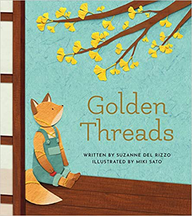
Golden Threads. Suzanne Del Rizzo.
Illustrated by Miki Sato. Owlkids, 2020 (K-3) Stewardship
Set in Japan and told from the viewpoint of a beloved stuffed fox, this poignant story is somewhat reminiscent of Corduroy. Emi, the fox's human, tucks a golden ginko leaf into his overalls just before a terrible storm blows him away and separates him from the only home he's ever known. Fox is found battered and torn and given to Kiko, a wheelchair-bound girl who loves him and repairs his tears with golden thread. Kiko can tell by the golden leaf in his pocket, that Fox has been loved by another, and she seeks her out. The golden ginko leaf leads Kiko and Fox to Emi. Although he has been broken and mended, he is now twice loved. Charming fabric and paper collages illustrate this lovely story. Available on Epic!
Illustrated by Miki Sato. Owlkids, 2020 (K-3) Stewardship
Set in Japan and told from the viewpoint of a beloved stuffed fox, this poignant story is somewhat reminiscent of Corduroy. Emi, the fox's human, tucks a golden ginko leaf into his overalls just before a terrible storm blows him away and separates him from the only home he's ever known. Fox is found battered and torn and given to Kiko, a wheelchair-bound girl who loves him and repairs his tears with golden thread. Kiko can tell by the golden leaf in his pocket, that Fox has been loved by another, and she seeks her out. The golden ginko leaf leads Kiko and Fox to Emi. Although he has been broken and mended, he is now twice loved. Charming fabric and paper collages illustrate this lovely story. Available on Epic!
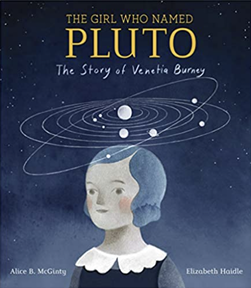
The Girl Who Named Pluto: The Story of Venetia Burney. Alice B. McGinty. Illustrated by Elizabeth Haidle. Schwartz & Wade, 2013. K-4 Wonder.
Inspiring true story of an eleven-year-old British girl whose wonder at the size and majesty of the solar system is sparked by a "planet walk." In 1929, Venetia Burney's teacher takes the class on a measured walk to understand how far the planets were from one another. Shortly thereafter, when Venetia learns yet another planet has been discovered (far beyond then-final Neptune), she knows it must be very dark and very cold. Her studies of Roman mythology trigger a thought: didn't Neptune have a brother named Pluto, who was god of the icy underworld? Why not call it Pluto? she suggests to her grandfather. It just so happens that her grandfather knows someone at the Royal Astronomical Society, who knows someone in Arizona (where the discovery was made). Pluto it is. Whimsy and wonder characterize the illustrations too.
Inspiring true story of an eleven-year-old British girl whose wonder at the size and majesty of the solar system is sparked by a "planet walk." In 1929, Venetia Burney's teacher takes the class on a measured walk to understand how far the planets were from one another. Shortly thereafter, when Venetia learns yet another planet has been discovered (far beyond then-final Neptune), she knows it must be very dark and very cold. Her studies of Roman mythology trigger a thought: didn't Neptune have a brother named Pluto, who was god of the icy underworld? Why not call it Pluto? she suggests to her grandfather. It just so happens that her grandfather knows someone at the Royal Astronomical Society, who knows someone in Arizona (where the discovery was made). Pluto it is. Whimsy and wonder characterize the illustrations too.
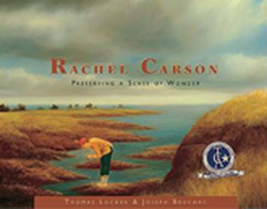
Rachel Carson: Preserving a Sense of Wonder. Joseph Bruchac. Illustrated by Thomas Locker. Fulcrum Publishing, 2009. (K-4) Stewardship
As a young girl growing up on a Pennsylvania farm, Rachel Carson was enchanted by the wonder of spring fog, bird song, sea and plant life. In this stunningly illustrated picture book biography, we learn how her childhood fascination formed the woman who would become one of our country's leading environmentalists. Rachel Carson's 1962 book Silent Spring made Americans think twice about how we treat the fragile ecosystems that sustain us. She became a major force for environmental conservation.
As a young girl growing up on a Pennsylvania farm, Rachel Carson was enchanted by the wonder of spring fog, bird song, sea and plant life. In this stunningly illustrated picture book biography, we learn how her childhood fascination formed the woman who would become one of our country's leading environmentalists. Rachel Carson's 1962 book Silent Spring made Americans think twice about how we treat the fragile ecosystems that sustain us. She became a major force for environmental conservation.
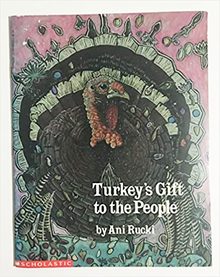
Turkey’s Gift to the People. Ani Rucki. Northland, AZ, 1992. (K-4) Stewardship
Navajo tale of cooperation at a time when Animal People ruled the earth and were threatened by a great flood. Each animal contributes his/her talents to save the group, but only Turkey remembers to bring the seeds they will need to begin again after the flood.
Navajo tale of cooperation at a time when Animal People ruled the earth and were threatened by a great flood. Each animal contributes his/her talents to save the group, but only Turkey remembers to bring the seeds they will need to begin again after the flood.
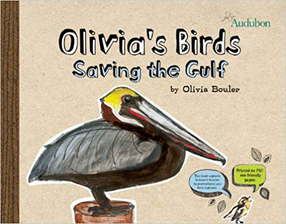
Olivia's Birds. Saving the Gulf. Olivia Bouler. Sterling Children’s Books, 2011. (K-4) Stewardship
A true story: eleven-year-old Olivia Bouler adores birds. She both studies and draws them. In 2010, when a giant oil spill endangered many birds in the Gulf of Mexico, Olivia wrote the Audubon Society and offered her help raising funds for their rescue by giving her artwork to those who would donate to the clean-up. The inspiring book (in Olivia’s own words) showcases her colorful and accurate drawings. It includes information on how others can continue to help the conservation of birds and it encourages young people to create their own solutions to big problems.
A true story: eleven-year-old Olivia Bouler adores birds. She both studies and draws them. In 2010, when a giant oil spill endangered many birds in the Gulf of Mexico, Olivia wrote the Audubon Society and offered her help raising funds for their rescue by giving her artwork to those who would donate to the clean-up. The inspiring book (in Olivia’s own words) showcases her colorful and accurate drawings. It includes information on how others can continue to help the conservation of birds and it encourages young people to create their own solutions to big problems.
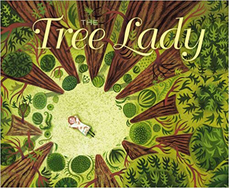
The Tree Lady: The True Story of How One Tree-Loving Woman Changed a City Forever. H. Joseph Hopkins. Illustrated by Jill McElmurry.
Beach Lane Books, 2013. (K-5) Stewardship, Wonder.
Charmingly told story of Kate Sessions, who grew up in the redwoods of Northern California, and became the first woman to graduate from the University of California with a degree in Science (1880s). Her passion for plants and trees followed her to a new home in San Diego, which she found barren and tree-less. Careful research and cultivation allowed her to create a garden from the desert, delightfully recalled in this splendid picture book.
Beach Lane Books, 2013. (K-5) Stewardship, Wonder.
Charmingly told story of Kate Sessions, who grew up in the redwoods of Northern California, and became the first woman to graduate from the University of California with a degree in Science (1880s). Her passion for plants and trees followed her to a new home in San Diego, which she found barren and tree-less. Careful research and cultivation allowed her to create a garden from the desert, delightfully recalled in this splendid picture book.
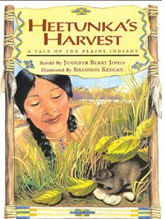
Heetunka’s Harvest: A Tale of the Plains Indians. Jennifer Berry Jones.
Illustrated by Shannon Keegan. Roberts Rinehart, 1998. (K-5)
Gratitude, Generosity
Plains Indian tale of a generous prairie mouse (Heetunka) who shares her carefully harvested beans and seeds with the Dakota people in exchange for gifts. An ungrateful woman takes all of Heetunka’s beans and learns the hard way that greed and ingratitude bring her only sorrow. Heetunka “will happily share with those who come to trade with humble and thankful hearts.”
Illustrated by Shannon Keegan. Roberts Rinehart, 1998. (K-5)
Gratitude, Generosity
Plains Indian tale of a generous prairie mouse (Heetunka) who shares her carefully harvested beans and seeds with the Dakota people in exchange for gifts. An ungrateful woman takes all of Heetunka’s beans and learns the hard way that greed and ingratitude bring her only sorrow. Heetunka “will happily share with those who come to trade with humble and thankful hearts.”
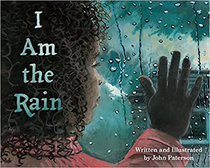
I Am the Rain.* John Paterson. Dawn Publications, 2018.(1-3) Wonder, Stewardship *Available on Epic!
A simple subject – the water cycle - is poetically presented along with gorgeous illustrations of the earth throughout different geographic areas and seasons. The water cycle does not illustrate virtue, but it will indeed inspire student wonder and awe, and hopefully foment good stewardship.
A simple subject – the water cycle - is poetically presented along with gorgeous illustrations of the earth throughout different geographic areas and seasons. The water cycle does not illustrate virtue, but it will indeed inspire student wonder and awe, and hopefully foment good stewardship.
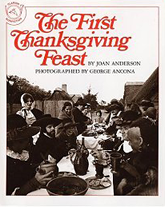
The First Thanksgiving Feast. Joan Anderson.
Photographed by George Ancona. Clarion, 1984. (1-3) Gratitude
Told in the first person by various “interpreters” (actors who recreate the lives of pilgrims) at Plymouth Plantation, this is the story of the First Thanksgiving. With photographs from historic Plymouth Plantation and text resonant of the times, we learn the story of the pilgrim’s first year and experience their gratitude, not just for their harvest, but for the grace of God in preserving them in this new land. The three-day celebration with the Wampanoag is beautifully captured.
Photographed by George Ancona. Clarion, 1984. (1-3) Gratitude
Told in the first person by various “interpreters” (actors who recreate the lives of pilgrims) at Plymouth Plantation, this is the story of the First Thanksgiving. With photographs from historic Plymouth Plantation and text resonant of the times, we learn the story of the pilgrim’s first year and experience their gratitude, not just for their harvest, but for the grace of God in preserving them in this new land. The three-day celebration with the Wampanoag is beautifully captured.
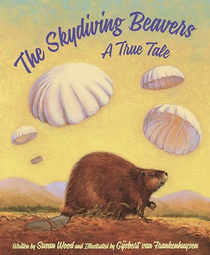
The Skydiving Beavers. A True Tale. Susan Wood. Illustrated by Gijsbert van Frankenhuyzen. Sleeping Bear Press, 2017. (1-4) Stewardship, Imagination, Wonder
McCall, Idaho is a beautiful place to live and beavers have thought so for a long time. After World War II, humans decided to settle there too, and the two species collided. Beaver dams flooded roads. And new homes eliminated foraging lands for beavers. Elmo Heter, who worked for the Idaho Department of Fish and Game, did not want to see the beavers die out; he came up with an imaginative solution. Open lands in Idaho miles away suited the beaver's needs perfectly, so why not use some World War II technology to give the beavers a new home? You guessed it. In 1948, seventy beavers, led by a courageous beaver named Geronimo (who seemed to enjoy the practice runs) parachuted safely into their new home. A playful, funny and true story with marvelous illustrations. (And also explanations of why this wouldn't work today...)
McCall, Idaho is a beautiful place to live and beavers have thought so for a long time. After World War II, humans decided to settle there too, and the two species collided. Beaver dams flooded roads. And new homes eliminated foraging lands for beavers. Elmo Heter, who worked for the Idaho Department of Fish and Game, did not want to see the beavers die out; he came up with an imaginative solution. Open lands in Idaho miles away suited the beaver's needs perfectly, so why not use some World War II technology to give the beavers a new home? You guessed it. In 1948, seventy beavers, led by a courageous beaver named Geronimo (who seemed to enjoy the practice runs) parachuted safely into their new home. A playful, funny and true story with marvelous illustrations. (And also explanations of why this wouldn't work today...)
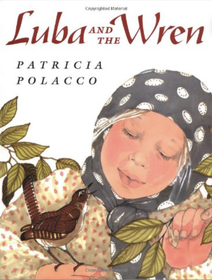
Luba and the Wren. Patricia Polacco. Philomel, 1999. Gratitude, Compassion, Gentleness, Humility. (1-4)
Luba lives in a little home on the edge of the forest, and though her house is humble and her clothes are simple, she is perfectly content. One day she saves the life of a small wren, and the wren promises to grant her anything she wishes for. Luba does not want anything, but her parents do—and their demands only grow more and more as they accumulate worldly power and possessions. At the end, the whole family learns that contentment is to be found in gratitude for what you have. Accompanied by a particularly gorgeous, folk-art inspired set of Polacco's illustrations, this is a Ukrainian-styled retelling of the Grimms' The Fisherman's Wife, but may be even more compelling for young readers.
Luba lives in a little home on the edge of the forest, and though her house is humble and her clothes are simple, she is perfectly content. One day she saves the life of a small wren, and the wren promises to grant her anything she wishes for. Luba does not want anything, but her parents do—and their demands only grow more and more as they accumulate worldly power and possessions. At the end, the whole family learns that contentment is to be found in gratitude for what you have. Accompanied by a particularly gorgeous, folk-art inspired set of Polacco's illustrations, this is a Ukrainian-styled retelling of the Grimms' The Fisherman's Wife, but may be even more compelling for young readers.

The Iguanodon's Horn: How Artists and Scientists Put a Dinosaur Back Together Again and Again and Again. Sean Rubin. Clarion Books, 2024. (1-4) Wonder, Diligence
Ever wonder how fossils go from finds to fully fleshed forms? This intricate and richly illustrated book illuminates paleoart—the way we envision how dinosaurs and other fauna and flora from paleolithic times may have looked. Rubin focuses on the changing ways Iguanadon was visualized over the years, and his detailed illustrations and historical sources enrich this story to appeal to dinosuar-loving adults and children alike. A powerful addition to the Core Knowledge 1st Grade Ice Age sequence or any unit on the scientific method. A triumph of wonder and diligence.
Ever wonder how fossils go from finds to fully fleshed forms? This intricate and richly illustrated book illuminates paleoart—the way we envision how dinosaurs and other fauna and flora from paleolithic times may have looked. Rubin focuses on the changing ways Iguanadon was visualized over the years, and his detailed illustrations and historical sources enrich this story to appeal to dinosuar-loving adults and children alike. A powerful addition to the Core Knowledge 1st Grade Ice Age sequence or any unit on the scientific method. A triumph of wonder and diligence.

John Ronald's Dragons: The Story of J.R.R. Tolkien. Caroline McAllister. Illustrated by Eliza Wheeler. Roaring Book Press, 2017. (1-4) Wonder, Wisdom, Diligence, Imagination.
John Ronald Reuel Tolkien would become one of the greatest fantasy writers the world would ever know, but he started out his life as a young boy obsessed with dragons. The author's and illustrator's obvious familiarity with the stories of Tolkien leads to clever tie-ins between John Ronald's childhood experience and his later work (intricate elven windows in the library where he holds a tea party, his headmaster's long beard and smoking pipe...) Vivid, lighthearted illustrations make this a joy to read for all ages.
John Ronald Reuel Tolkien would become one of the greatest fantasy writers the world would ever know, but he started out his life as a young boy obsessed with dragons. The author's and illustrator's obvious familiarity with the stories of Tolkien leads to clever tie-ins between John Ronald's childhood experience and his later work (intricate elven windows in the library where he holds a tea party, his headmaster's long beard and smoking pipe...) Vivid, lighthearted illustrations make this a joy to read for all ages.

Queen of Physics: How Wu Chien Shiung Helped Unlock the Secrets of the Atom. Teresa Robeson. Illustrated by Rebecca Huang. Union Square Kids, 2019. (1-3) Diligence, Wonder, Perseverance, Courage, Women's History Month
Wu Chien Shiung was born in China in 1912 to an unusual family: parents who believed that girls had the same right to learn as boys, and who started a school to teach girls. The daughter's name meant “courageous hero.” And she indeed grew up to do great things, eventually traveling to Berkeley, California to do groundbreaking work in nuclear physics. As a woman of Asian descent in the 1930s, Wu Chien had an uphill battle in her field, but was undeterred. Geared to younger kids, this book does a good job of explaining Wu’s work in a way that everyone can understand, but the subject material and glossary at the end ensure that adults and older kids will also learn a lot from this book.
Wu Chien Shiung was born in China in 1912 to an unusual family: parents who believed that girls had the same right to learn as boys, and who started a school to teach girls. The daughter's name meant “courageous hero.” And she indeed grew up to do great things, eventually traveling to Berkeley, California to do groundbreaking work in nuclear physics. As a woman of Asian descent in the 1930s, Wu Chien had an uphill battle in her field, but was undeterred. Geared to younger kids, this book does a good job of explaining Wu’s work in a way that everyone can understand, but the subject material and glossary at the end ensure that adults and older kids will also learn a lot from this book.
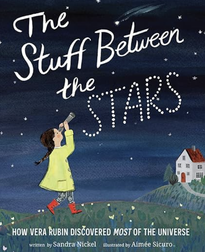
The Stuff Between the Stars: How Vera Rubin Discovered Most of the Universe. Sandra Nickel. Illustrated by Aimée Sicuro. Harry N. Abrams, 2021. (1-4) Perseverance, Wonder
The true story of astronomer Vera Rubin, who discovered dark matter in galaxies. She goes to college and majors in astronomy, and despite the prejudice against women in academia, she pursues the big questions that call to her: what is between the stars? How are the galaxies arranged? A particular strength of this book is its depiction of Vera marrying and having children while also pursuing her passionate study of astronomy.
The true story of astronomer Vera Rubin, who discovered dark matter in galaxies. She goes to college and majors in astronomy, and despite the prejudice against women in academia, she pursues the big questions that call to her: what is between the stars? How are the galaxies arranged? A particular strength of this book is its depiction of Vera marrying and having children while also pursuing her passionate study of astronomy.
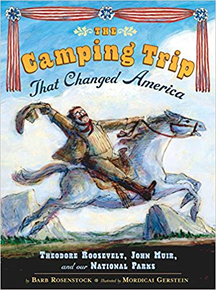
The Camping Trip that Changed America: Theodore Roosevelt, John Muir, and Our National Parks. Barb Rosenstock. Illustrated by Mordicai Gerstein. Dial Books, 2012. (1-4) Stewardship, Wonder
An avid outdoorsman and naturalist, Teddy Roosevelt eagerly read the work of his contemporary, budding environmentalist John Muir. Could Muir be right that the nation's wilderness was at risk? The nation's youngest president decides to embark on a camping trip with Mr. Muir to find out for himself. This is a wonderful dramatization of the two men's adventure in the northwest, and explains the origins of America's national parks. Loose and lively illustrations accompany an energetic text. (Also see our recommendations for John Muir.)
An avid outdoorsman and naturalist, Teddy Roosevelt eagerly read the work of his contemporary, budding environmentalist John Muir. Could Muir be right that the nation's wilderness was at risk? The nation's youngest president decides to embark on a camping trip with Mr. Muir to find out for himself. This is a wonderful dramatization of the two men's adventure in the northwest, and explains the origins of America's national parks. Loose and lively illustrations accompany an energetic text. (Also see our recommendations for John Muir.)
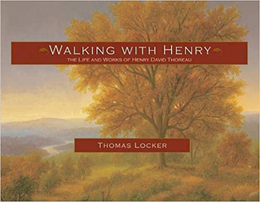
Walking with Henry: The Life and Works of Henry David Thoreau. Thomas Locker. Fulcrum Publishing, 2011. (1-5) Wonder, Gratitude, Wisdom, Stewardship
Thomas Locker surpasses himself with this hauntingly beautiful volume on America's iconic poet-philosopher Henry David Thoreau. A student of nature, Henry David Thoreau revered it as a source of understanding and wisdom. After reading the book, the only thing you can be sure of is that students will want to join him and take a walk in the woods! This triumph can be used at many grade levels.
Thomas Locker surpasses himself with this hauntingly beautiful volume on America's iconic poet-philosopher Henry David Thoreau. A student of nature, Henry David Thoreau revered it as a source of understanding and wisdom. After reading the book, the only thing you can be sure of is that students will want to join him and take a walk in the woods! This triumph can be used at many grade levels.
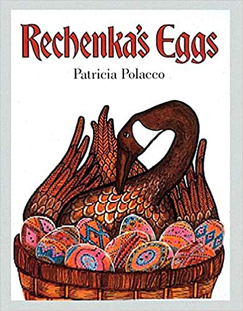
Rechenka’s Eggs. Patricia Polacco. Putnam, 1988. (2-4)
Poor Russian peasant woman aids and cares for a wounded goose, undergoes trials as result, but is richly rewarded in the end. A tale of hope, rebirth, and miracles as well as compassion.
Poor Russian peasant woman aids and cares for a wounded goose, undergoes trials as result, but is richly rewarded in the end. A tale of hope, rebirth, and miracles as well as compassion.
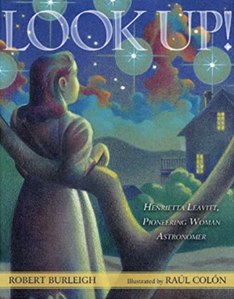
Look Up!: Henrietta Leavitt, Pioneering Woman Astronomer. Robert Burleigh. Illustrated by Raúl Colón. Simon & Schuster/Paula Wiseman Books, 2013. (2-4) Wonder, Diligence, Perseverance. "She wanted to know more about the wonderful bigness of all she saw." Henrietta Leavitt, who studied astronomy at Radcliffe in the 1890s, took an entry-level job at Harvard's Observatory, measuring positions of stars so that she could eventually get a chance to study the heavens. She revolutionized the understanding of the size of the universe with her approach to measuring large distances in space. Williamina Fleming, brought to life in Kathryn Lasky's She Caught the Light, was her contemporary and colleague. Both women were initially hired as "computers" (engaged to simply to compute results) but became scientists in their own right, making major discoveries in the wondrous field of astronomy. Wonder-fully illustrated too.

What Miss Mitchell Saw. Hayley Barrett. Illustrated by Diana Sudyka. Beach Lane Books, 2019. (2-4) Wonder, Diligence, Women’s History Month.
Nantucket-born Maria Mitchell grows up enthralled by the stars, and the sky is her sea. First as a teacher and then as a librarian, she keeps her sense of wonder alive, scanning the skies nightly and naming all the heavenly bodies she sees there. Then, on an October evening in 1847, she sees something never before seen—a new comet. Will Miss Mitchell get the credit for sighting the comet first, even though it takes so long for her letter to reach Europe that a Vatican astronomer claims the comet in the meantime? Yes, she will! Beguiling illustrations of the night sky, an informative fact section at the end, and the distinctive influence of Mitchell’s Quaker upbringing will interest both younger and older kids.
Nantucket-born Maria Mitchell grows up enthralled by the stars, and the sky is her sea. First as a teacher and then as a librarian, she keeps her sense of wonder alive, scanning the skies nightly and naming all the heavenly bodies she sees there. Then, on an October evening in 1847, she sees something never before seen—a new comet. Will Miss Mitchell get the credit for sighting the comet first, even though it takes so long for her letter to reach Europe that a Vatican astronomer claims the comet in the meantime? Yes, she will! Beguiling illustrations of the night sky, an informative fact section at the end, and the distinctive influence of Mitchell’s Quaker upbringing will interest both younger and older kids.
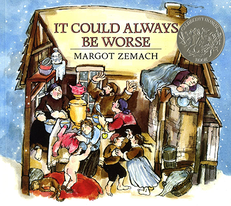
It Could Always Be Worse. A Yiddish Folktale. Margot Zemach.
Square Fish, 1990. (2-4) Gratitude
Written in 1977, this classic is still in print with its timeless message of appreciating what one has rather than seeing the glass half-empty. A family of nine lives in a tiny home, where tempers are short and arguments many. When the beleaguered peasant father goes to a rabbi for advice, he’s told to invite the chickens and geese inside, then still more critters. Uproariously funny situations result, as things go from bad to worse, and the original family dwelling starts to seem like paradise. Terrific illustrations.
Square Fish, 1990. (2-4) Gratitude
Written in 1977, this classic is still in print with its timeless message of appreciating what one has rather than seeing the glass half-empty. A family of nine lives in a tiny home, where tempers are short and arguments many. When the beleaguered peasant father goes to a rabbi for advice, he’s told to invite the chickens and geese inside, then still more critters. Uproariously funny situations result, as things go from bad to worse, and the original family dwelling starts to seem like paradise. Terrific illustrations.
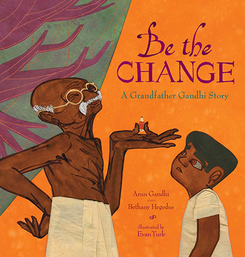
Be the Change. A Grandfather Gandhi Story. Arun Gandhi and Bethany Hegedus. Illustrated by Evan Turk. Atheneum Books, 2016. (2-4)
Respect, Stewardship, Service
Young Arun, grandson of Mahatma Gandhi, lives in the Ashram or “service village,” founded by his grandfather (all are there to serve others). He listens closely as his grandfather explains how the eleven vows of the ashram help promote peace, but he has a particular problem with the vow to avoid "wastefulness." Gandhi has Arun create a tree of violence that traces how seemingly small, thoughtless actions lead to harsh consequences. Bright, colorful collage illustrations help make difficult concepts approachable.
Respect, Stewardship, Service
Young Arun, grandson of Mahatma Gandhi, lives in the Ashram or “service village,” founded by his grandfather (all are there to serve others). He listens closely as his grandfather explains how the eleven vows of the ashram help promote peace, but he has a particular problem with the vow to avoid "wastefulness." Gandhi has Arun create a tree of violence that traces how seemingly small, thoughtless actions lead to harsh consequences. Bright, colorful collage illustrations help make difficult concepts approachable.
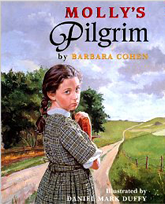
Molly’s Pilgrim. Barbara Cohen.
Illustrated by Daniel Mark Duffy. Harper Collins, 1998 (2-4)Gratitude, Respect
Molly is a third grader, whose Jewish family has emigrated to the United States from Russia. She experiences the taunting of classmates, who tease her about her accent, the size of her eyes, and the shape of her nose. Then one day Molly is given a Thanksgiving assignment to make a pilgrim doll for a school diorama. The children are reminded that the Pilgrims left England for the freedom to practice their religion (just like Molly’s family). The doll Molly brings to class might be a source of more laughter and scorn, but classmates learn that “it takes all kinds of pilgrims to make Thanksgiving.” And Molly learns she has a lot to be thankful for. This is a heart-wrenching story: the pathos and taunting may make it too heavy for K-1, but second to fourth graders will deeply appreciate it.
Illustrated by Daniel Mark Duffy. Harper Collins, 1998 (2-4)Gratitude, Respect
Molly is a third grader, whose Jewish family has emigrated to the United States from Russia. She experiences the taunting of classmates, who tease her about her accent, the size of her eyes, and the shape of her nose. Then one day Molly is given a Thanksgiving assignment to make a pilgrim doll for a school diorama. The children are reminded that the Pilgrims left England for the freedom to practice their religion (just like Molly’s family). The doll Molly brings to class might be a source of more laughter and scorn, but classmates learn that “it takes all kinds of pilgrims to make Thanksgiving.” And Molly learns she has a lot to be thankful for. This is a heart-wrenching story: the pathos and taunting may make it too heavy for K-1, but second to fourth graders will deeply appreciate it.
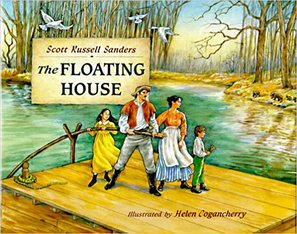
The Floating House. Scott Russell Sanders.
Illustrated by Helen Cogancherry. Atheneum, 1995. (2-4)
Set in 1815, the McClure family floats down the Ohio River in a flatboat to find a new home fur- ther west in Jeffersonville, Indiana. This is a rich picture book and fine piece of fiction depicting the excitement and wonder of a young family exploring an uncharted wilderness. The McClures “were eager to reach the wild country downstream, where you could buy farms for a dollar an acre and the dirt was so rich people said you could plant a stick and it would break out in leaves.” The family finds its home, but the children still dream of “riding the river once more, heading downstream to unknown places.”
Illustrated by Helen Cogancherry. Atheneum, 1995. (2-4)
Set in 1815, the McClure family floats down the Ohio River in a flatboat to find a new home fur- ther west in Jeffersonville, Indiana. This is a rich picture book and fine piece of fiction depicting the excitement and wonder of a young family exploring an uncharted wilderness. The McClures “were eager to reach the wild country downstream, where you could buy farms for a dollar an acre and the dirt was so rich people said you could plant a stick and it would break out in leaves.” The family finds its home, but the children still dream of “riding the river once more, heading downstream to unknown places.”
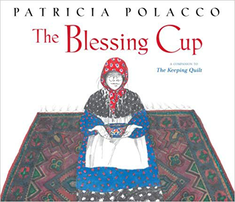
The Blessing Cup. Patricia Polacco.
Simon and Schuster, 2013. (2-4) Gratitude
A poor family in turn-of-the-century Russia counts their blessings each day as they drink from their one special possession – a beautiful china tea set. They consider themselves rich because they have each other and their life has “flavor.” The flavor turns bitter when pogroms force them to flee. We follow their attempts to find safety, friends who aid them, and their move to America (at which point they have only one blessing cup because they’ve given the rest of the set away in gratitude to those who helped them). Each night concludes with a drink from the Blessing Cup and reflection on the blessings in their lives. A wonderful reminder of the many blessings to count in our lives.
Simon and Schuster, 2013. (2-4) Gratitude
A poor family in turn-of-the-century Russia counts their blessings each day as they drink from their one special possession – a beautiful china tea set. They consider themselves rich because they have each other and their life has “flavor.” The flavor turns bitter when pogroms force them to flee. We follow their attempts to find safety, friends who aid them, and their move to America (at which point they have only one blessing cup because they’ve given the rest of the set away in gratitude to those who helped them). Each night concludes with a drink from the Blessing Cup and reflection on the blessings in their lives. A wonderful reminder of the many blessings to count in our lives.
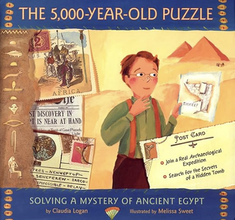
The 5,000 Year Old Puzzle: Solving a Mystery of Ancient Egypt. Claudia Logan. Illustrated by Melissa Sweet. Farrar, Straus and Giroux, 2002. (3-4) Wonder, Stewardship, Diligence.
Young sleuths will enjoy this educational deep dive into an ancient Egyptian archeological dig. In 1922, King Tut's tomb was discovered, and a real expedition went to the site, led by Dr. George Reisner. This book tells the tale of this expedition through the diaries of a fictional young Will Hunt, allowing readers to follow all its twists and turns: a glimpse into the science of archaeology and its high stakes for preservation, as well as the amazing discoveries that can be made along the way.
Young sleuths will enjoy this educational deep dive into an ancient Egyptian archeological dig. In 1922, King Tut's tomb was discovered, and a real expedition went to the site, led by Dr. George Reisner. This book tells the tale of this expedition through the diaries of a fictional young Will Hunt, allowing readers to follow all its twists and turns: a glimpse into the science of archaeology and its high stakes for preservation, as well as the amazing discoveries that can be made along the way.
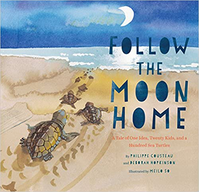
Follow the Moon Home. Philippe Cousteau and Deborah Hopkinson. Illustrated by Meilo So. Chronicle Books, 2016. (2-5) Stewardship
Vivienne sometimes gets lost in her new seaside town. Maybe that gives her special empathy for the disoriented baby sea turtles she observes on the beach. The town's loggerhead turtles hatch in sand, and then at night must find their way to the ocean to survive, but Vivienne notices they are struggling, distracted by the lights of the nearby houses. For a science class she and her friends are tasked with finding a problem to solve, and she chooses to help these turtles find their way to their true home. "Lights out for Loggerheads" is her slogan. A lovely book of wonder, stewardship, and responsibility. Charming watercolor illustrations.
Vivienne sometimes gets lost in her new seaside town. Maybe that gives her special empathy for the disoriented baby sea turtles she observes on the beach. The town's loggerhead turtles hatch in sand, and then at night must find their way to the ocean to survive, but Vivienne notices they are struggling, distracted by the lights of the nearby houses. For a science class she and her friends are tasked with finding a problem to solve, and she chooses to help these turtles find their way to their true home. "Lights out for Loggerheads" is her slogan. A lovely book of wonder, stewardship, and responsibility. Charming watercolor illustrations.
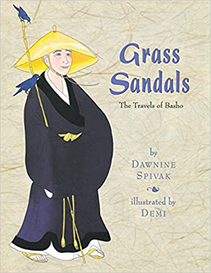
Spivak, Dawnine. Grass Sandals: The Travels of Basho.
Illustrated by Demi. Atheneum Books, 2009. (2-5)
Basho, a Japanese poet renown for haiku, “would sit in the doorway of his small house, sit with his breakfast bowl, look out at the river and mountains, and pour his tea in the company of morning glories.” One day Basho closes up his small home and begins his walk across Japan in his grass sandals and black robe. With simple, elegant illustrations and quiet, playful text, Grass Sandals invites elementary school children to experience the gentle beauty of nature, Japan, and the simplicity of haiku. The author’s daughter complained: “Mom, nothing happens in this book.” Your children may also complain, but more likely they’ll be caught up in the wonder and serenity of Demi’s charmingly restrained Buddhist world. Use with Japan unit in 2nd grade. Excellent tie-in with 5th grade unit on Buddhism.
Illustrated by Demi. Atheneum Books, 2009. (2-5)
Basho, a Japanese poet renown for haiku, “would sit in the doorway of his small house, sit with his breakfast bowl, look out at the river and mountains, and pour his tea in the company of morning glories.” One day Basho closes up his small home and begins his walk across Japan in his grass sandals and black robe. With simple, elegant illustrations and quiet, playful text, Grass Sandals invites elementary school children to experience the gentle beauty of nature, Japan, and the simplicity of haiku. The author’s daughter complained: “Mom, nothing happens in this book.” Your children may also complain, but more likely they’ll be caught up in the wonder and serenity of Demi’s charmingly restrained Buddhist world. Use with Japan unit in 2nd grade. Excellent tie-in with 5th grade unit on Buddhism.
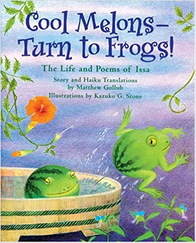
Cool Melons—Turn to Frogs! The Life and Poems of Issa. Matthew Gollub.
Illustrated by Kazuko G. Stone. Lee and Low Books, 1998. (2-5)
Brother Issa, the renowned Japanese master of Haiku (1763-1827), delighted from an early age in the cries of insects and the songs of farmers as they worked. In this beautifully illustrated volume the poet comes to life through his haiku and his wide-open wonder at the world around him. Particularly good for use with Japan unit in 2nd grade or Feudal Japan in 5th grade.
Illustrated by Kazuko G. Stone. Lee and Low Books, 1998. (2-5)
Brother Issa, the renowned Japanese master of Haiku (1763-1827), delighted from an early age in the cries of insects and the songs of farmers as they worked. In this beautifully illustrated volume the poet comes to life through his haiku and his wide-open wonder at the world around him. Particularly good for use with Japan unit in 2nd grade or Feudal Japan in 5th grade.
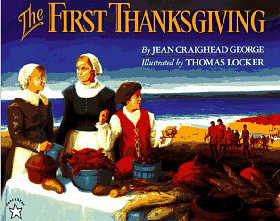
The First Thanksgiving. Jean Craighead George.
Illustrated by Thomas Locker. Puffin, 2001. (2-5) Gratitude
Quintessentially capable story teller, Jean Craighead George, brings her gift to this substantial retelling of the First Thanksgiving. She begins her lyrical narrative with the formation of Plymouth Rock at the end of the last Ice Age, describes the settlement of the Pawtuxet tribe thousands of years later, that tribe’s first encounter with Englishmen, the 1620 settlement and sufferings of the Mayflower pilgrims, their efforts and perseverance to survive and ultimately secure a good harvest. It is a book that inspires admiration for the efforts of the many peoples who have called Plymouth home, gratitude for blessings given, and respect/stewardship for the gifts of nature. Stunning illustrations by Locker accompany substantial text.
Illustrated by Thomas Locker. Puffin, 2001. (2-5) Gratitude
Quintessentially capable story teller, Jean Craighead George, brings her gift to this substantial retelling of the First Thanksgiving. She begins her lyrical narrative with the formation of Plymouth Rock at the end of the last Ice Age, describes the settlement of the Pawtuxet tribe thousands of years later, that tribe’s first encounter with Englishmen, the 1620 settlement and sufferings of the Mayflower pilgrims, their efforts and perseverance to survive and ultimately secure a good harvest. It is a book that inspires admiration for the efforts of the many peoples who have called Plymouth home, gratitude for blessings given, and respect/stewardship for the gifts of nature. Stunning illustrations by Locker accompany substantial text.
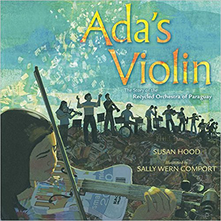
Ada’s Violin: The Story of the Recycled Orchestra of Paraguay.
Susan Hood. Illustrated by Sally Wern Comport. Simon and Schuster, 2016. (2-5) Stewardship
Eleven-year-old Ada is growing up in Cateura, a bleak town perched on a landfill in Paraguay. Ada thinks the garbage truck that arrives each morning is “a box of surprises. One never knew what might be inside.” When music teacher Favio Chavez arrives in her town, Ada is entranced, and longs to play the violin, but of course her family cannot afford one. Chavez encourages the children to recognize the richness of what is around them. He teaches them how to fashion musical instruments from the debris. “The world sends us garbage. We send back music.” In this true story, the “Recycled Orchestra” is his gift to the children of the slums, and Ada triumphs. The illustrations (often collages) capture the hope of the children, and the lyrical text charts their strides. A book of stewardship, as well as resourcefulness, and of hope in the darkness.
Susan Hood. Illustrated by Sally Wern Comport. Simon and Schuster, 2016. (2-5) Stewardship
Eleven-year-old Ada is growing up in Cateura, a bleak town perched on a landfill in Paraguay. Ada thinks the garbage truck that arrives each morning is “a box of surprises. One never knew what might be inside.” When music teacher Favio Chavez arrives in her town, Ada is entranced, and longs to play the violin, but of course her family cannot afford one. Chavez encourages the children to recognize the richness of what is around them. He teaches them how to fashion musical instruments from the debris. “The world sends us garbage. We send back music.” In this true story, the “Recycled Orchestra” is his gift to the children of the slums, and Ada triumphs. The illustrations (often collages) capture the hope of the children, and the lyrical text charts their strides. A book of stewardship, as well as resourcefulness, and of hope in the darkness.
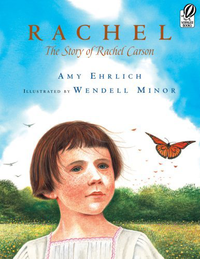
Rachel. The Story of Rachel Carson. Amy Ehrlich.
Illustrated by Wendell Minor. Harcourt Books, 2008. (2-5) Stewardship, Lives to Learn From
Gorgeous illustrations of the natural world highlight this thoughtful biography of Rachel Carson, who from an early age loved writing and nature. As an undergraduate, Rachel intended to become a writer, but changed her major to biology after a particularly intriguing course. Her adult life married her twin passions, and as the author of Silent Spring, Carson became an early champion of the environment, urging caution in the use of pesticides and DDT. The illustrations are stunning and the rich, lyrically told story will inspire young people. (NB: The book needed a better content editor: sentence structure on one page suggests that whales are fish and that plankton density is higher than it is, but our judgment is in favor of the book.)
Illustrated by Wendell Minor. Harcourt Books, 2008. (2-5) Stewardship, Lives to Learn From
Gorgeous illustrations of the natural world highlight this thoughtful biography of Rachel Carson, who from an early age loved writing and nature. As an undergraduate, Rachel intended to become a writer, but changed her major to biology after a particularly intriguing course. Her adult life married her twin passions, and as the author of Silent Spring, Carson became an early champion of the environment, urging caution in the use of pesticides and DDT. The illustrations are stunning and the rich, lyrically told story will inspire young people. (NB: The book needed a better content editor: sentence structure on one page suggests that whales are fish and that plankton density is higher than it is, but our judgment is in favor of the book.)
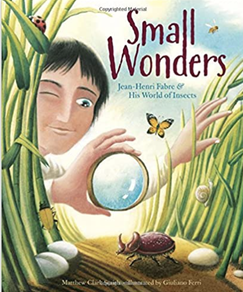
Small Wonders: Jean-Henri Fabre and His World of Insects. Matthew Clark Smith. Illustrated by Giuliano Ferri. Two Lions, 2015. 2-5. Wonder, Stewardship, Diligence. All the children in this nineteenth century French village know the strange man who talks to beetles and stays up late at night to watch spiders spin webs. What the children don't know is that Jean-Henri Fabre is one of the most famous naturalists of all time, having written many popular books on the behavior of the animals he watches so closely. The book takes us back to his childhood and his professional work with a fascinating array of beetles, wasps, and spiders. A lyrically written and charmingly illustrated introduction to the famous nineteenth century entomologist. His wonder and respect for the natural world would inspire many generations after him and will no doubt inspire the readers of this book.
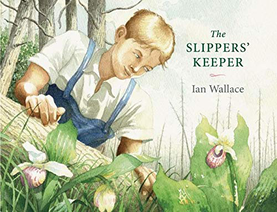
The Slippers’ Keeper.* Ian Wallace. Groundwood Books, 2015 *on Epic! (2-6) Stewardship, Perseverance, Beauty
One doesn't associate Canada with orchids in the wild, but we should. In this true story, thirteen-year-old Joe Purdon discovers a patch of rare Lady Slipper orchids in the woods on his family farm. Their unique shape and beauty enchant him. He learns that it takes 7 to 15 years for a plant to bloom, and sets out to help them propagate. While his dad is opposed to Joe spending time on such frivolities, Joe promises to work with the orchids only after all his other chores are done. It becomes a lifelong passion that Joe passes on to his daughter, leaving a legacy of sixteen thousand Showy Lady Slippers. Lovely watercolor illustrations.
One doesn't associate Canada with orchids in the wild, but we should. In this true story, thirteen-year-old Joe Purdon discovers a patch of rare Lady Slipper orchids in the woods on his family farm. Their unique shape and beauty enchant him. He learns that it takes 7 to 15 years for a plant to bloom, and sets out to help them propagate. While his dad is opposed to Joe spending time on such frivolities, Joe promises to work with the orchids only after all his other chores are done. It becomes a lifelong passion that Joe passes on to his daughter, leaving a legacy of sixteen thousand Showy Lady Slippers. Lovely watercolor illustrations.
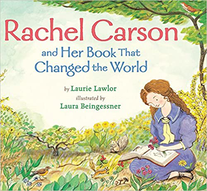
Rachel Carson and Her Book that Changed the World. Laurie Lawlor. Illustrated by Laura Beingessner. Holiday House, 2014. Wonder, Diligence, Stewardship (2-6)
This is a fine introductory biography to a pioneer in environmental science and the author of Silent Spring. As a child exploring Pennsylvania woods, Rachel learned to recognize the call of a yellowthroat and the song of a wood thrush. The family farm constantly fed her curiosity and both parents knew how important education was, sacrificing much to send Rachel to college, where she studied biology. But hard times of the Depression followed and after graduating, Rachel considered herself fortunate to find a job writing for a radio program about sea life. This led to articles for scientific journals, however, and soon her research became well known. She loved writing about nature."Once you are aware of the wonder and beauty of the earth, you will want to learn about it."
This is a fine introductory biography to a pioneer in environmental science and the author of Silent Spring. As a child exploring Pennsylvania woods, Rachel learned to recognize the call of a yellowthroat and the song of a wood thrush. The family farm constantly fed her curiosity and both parents knew how important education was, sacrificing much to send Rachel to college, where she studied biology. But hard times of the Depression followed and after graduating, Rachel considered herself fortunate to find a job writing for a radio program about sea life. This led to articles for scientific journals, however, and soon her research became well known. She loved writing about nature."Once you are aware of the wonder and beauty of the earth, you will want to learn about it."
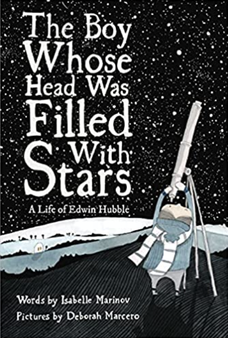
The Boy Whose Head Was Filled with Stars: A Life of Edwin Hubble. Isabelle Marinov. Illustrated by Deborah Marcero. Enchanted Lion Books, 2021. Wonder, Diligence. (2-6)
How many stars are in the sky? How did the universe begin? Where did it come from? Little Edwin Hubble gazed at the Missouri skies and wondered. On his eighth birthday his grandfather gave him a telescope, and he began to pursue his passion. In his career as an astronomer, he identified previously unknown stars, helped dramatically revise estimates of the universe's sprawling size and established that it was constantly expanding. This is gloriously illustrated and beautifully told.
How many stars are in the sky? How did the universe begin? Where did it come from? Little Edwin Hubble gazed at the Missouri skies and wondered. On his eighth birthday his grandfather gave him a telescope, and he began to pursue his passion. In his career as an astronomer, he identified previously unknown stars, helped dramatically revise estimates of the universe's sprawling size and established that it was constantly expanding. This is gloriously illustrated and beautifully told.
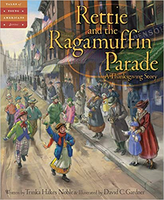
Rettie and the Ragamuffin Parade.* Trina Hakes Noble.
Illustrated by David C.Gardner. Sleeping Bear Press, 2017. (2-6) Diligence, Gratitude
Eerily appropriate to our time, this moving story is set in New York City's Lower East side during the 1918 influenza. Resourceful nine-year-old Rettie (Loretta) is trying to keep her Polish immigrant family together. Her dad is at war (World War I) and mom has been bedridden for months. Rettie fears if her mother dies, they'll all be sent to an orphanage. She does as many odd jobs as she can to bring in money for food and to care for her mother, but she looks forward to the "Ragamuffin Parade," when poor children parade down Broadway with hands out calling "Have ya anythin' for thanksgiving?" and are showered with pennies. The parade culminates in a "penny scramble" where pennies are tossed into the air, and the feistiest are rewarded. Because of her hard work and enterprise, Rettie does well. By Thanksgiving 1918, the war is over, her mother is recovering, and Rettie has much to be thankful for. The images of life in 1918-- nurses in masks checking the tenements, quarantine notices on the door, and people doing their best to just stay afloat -- are very touching. *Available on Epic!
Illustrated by David C.Gardner. Sleeping Bear Press, 2017. (2-6) Diligence, Gratitude
Eerily appropriate to our time, this moving story is set in New York City's Lower East side during the 1918 influenza. Resourceful nine-year-old Rettie (Loretta) is trying to keep her Polish immigrant family together. Her dad is at war (World War I) and mom has been bedridden for months. Rettie fears if her mother dies, they'll all be sent to an orphanage. She does as many odd jobs as she can to bring in money for food and to care for her mother, but she looks forward to the "Ragamuffin Parade," when poor children parade down Broadway with hands out calling "Have ya anythin' for thanksgiving?" and are showered with pennies. The parade culminates in a "penny scramble" where pennies are tossed into the air, and the feistiest are rewarded. Because of her hard work and enterprise, Rettie does well. By Thanksgiving 1918, the war is over, her mother is recovering, and Rettie has much to be thankful for. The images of life in 1918-- nurses in masks checking the tenements, quarantine notices on the door, and people doing their best to just stay afloat -- are very touching. *Available on Epic!
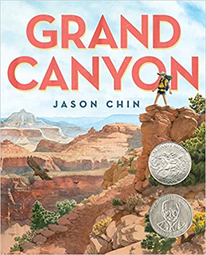
Grand Canyon.* Jason Chin.
Roaring Book Press, 2017. (2-6) Stewardship, Wonder, Love of Country.
This book should have been called "The Grandest Canyon." Jason Chin's gorgeous illustrations carry the day in this journey across the canyon (moving from North to South rims). Using a mountain lion, who follows the North Kaibab Trail, and a father and daughter, who explore the South Kaibab trail, Chin takes us through the history of the canyon's formation along with wonderful explanations and illustration of the flora, fauna, and habitat. Kids can imagine themselves as the child hiking with her Dad through the canyon. It is a wonderful introduction to the beauty of this National Park, and a good science resource too (habitats, ecosystems). *Available on Epic!
Roaring Book Press, 2017. (2-6) Stewardship, Wonder, Love of Country.
This book should have been called "The Grandest Canyon." Jason Chin's gorgeous illustrations carry the day in this journey across the canyon (moving from North to South rims). Using a mountain lion, who follows the North Kaibab Trail, and a father and daughter, who explore the South Kaibab trail, Chin takes us through the history of the canyon's formation along with wonderful explanations and illustration of the flora, fauna, and habitat. Kids can imagine themselves as the child hiking with her Dad through the canyon. It is a wonderful introduction to the beauty of this National Park, and a good science resource too (habitats, ecosystems). *Available on Epic!

The Day-Glo Brothers: The True Story of Bob and Joe Switzer’s Bright Ideas and Brand-New Colors. Chris Barton. Illustrated by Tony Persiani. Charlesbridge, 2009. (3-6) Imagination, Wonder.
Two inventive brothers are full of new ideas—flying planes, inventing a device to make their pharmacist father’s life easier, doing new and stunning magic tricks. When one brother is injured and recovering in the basement, the bored brothers decide to try out something they read about in Popular Mechanics: ultraviolet light. Lots of experimenting later, they’ve found a way to make paint glow. Whimsical illustrations in black and white give way gradually to more and more colorful illustrations in Day-Glo colors that will glow under a black light—a delightful trick that will help a wordy book engage younger kids too.
Two inventive brothers are full of new ideas—flying planes, inventing a device to make their pharmacist father’s life easier, doing new and stunning magic tricks. When one brother is injured and recovering in the basement, the bored brothers decide to try out something they read about in Popular Mechanics: ultraviolet light. Lots of experimenting later, they’ve found a way to make paint glow. Whimsical illustrations in black and white give way gradually to more and more colorful illustrations in Day-Glo colors that will glow under a black light—a delightful trick that will help a wordy book engage younger kids too.

The Tree of Life: How a Holocaust Sapling Inspired the World. Elisa Boxer. Illustrated by Alianna Rozentsveig. (3-6) Hope, Stewardship, Schools of Faith
The story of young Jewish children and their teacher who smuggled a sapling into their concentration camp in the Czech Republic in celebration of a Jewish holiday, sharing their precious water to allow it to grow. By the time the children were freed, the tree was five feet tall, and when people visited the concentration camp at Terezin to remember its history, they saw a huge, 60-foot tree there. The tree was overcome by a flood in 2007, but 600 saplings from the tree are now around the world—including the Museum of Jewish History in New York City—symbolizing hope for growth out of tragedy.
The story of young Jewish children and their teacher who smuggled a sapling into their concentration camp in the Czech Republic in celebration of a Jewish holiday, sharing their precious water to allow it to grow. By the time the children were freed, the tree was five feet tall, and when people visited the concentration camp at Terezin to remember its history, they saw a huge, 60-foot tree there. The tree was overcome by a flood in 2007, but 600 saplings from the tree are now around the world—including the Museum of Jewish History in New York City—symbolizing hope for growth out of tragedy.
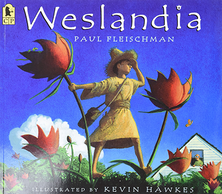
Weslandia. Paul Fleischman. Illustrated by Kevin Hawkes. Candlewick, 2002. (3-6) Wonder, Imagination, Stewardship
Wesley doesn’t think like other children. From his suburban backyard he imagines his own self-sufficient civilization, in which fantastical plants feed, clothe, shelter and provide many unexpected benefits in the hands of a creative kid. There is no waste. The intricate illustrations will draw the children in as they contemplate the connectedness of all things.
Wesley doesn’t think like other children. From his suburban backyard he imagines his own self-sufficient civilization, in which fantastical plants feed, clothe, shelter and provide many unexpected benefits in the hands of a creative kid. There is no waste. The intricate illustrations will draw the children in as they contemplate the connectedness of all things.
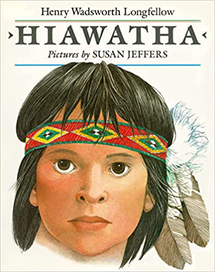
Song of Hiawatha. Henry Wadsworth Longfellow.
Illustrated by Susan Jeffers. Puffin, 1996. (3-6)
Longfellow’s Hiawatha is not the Iroquois leader of history, but in this mesmerizing epic poem Longfellow’s words and Jeffers’s art recreate the wonder of a young Indian child exploring nature and his world. Works well with 3rd grade Native American unit.
Illustrated by Susan Jeffers. Puffin, 1996. (3-6)
Longfellow’s Hiawatha is not the Iroquois leader of history, but in this mesmerizing epic poem Longfellow’s words and Jeffers’s art recreate the wonder of a young Indian child exploring nature and his world. Works well with 3rd grade Native American unit.
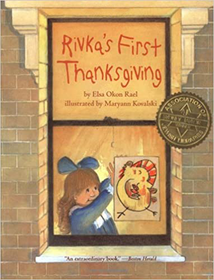
Rivka's First Thanksgiving. Elsa Okon Rael. Illustrated by Maryann Kovalski.
Margaret McElderry, 2001. (3-6) Gratitude, Love of Country
Set on the Lower East Side of New York in the 1910s, this is the story of a Jewish immigrant child who wants her newly arrived family to celebrate Thanksgiving. Nine-year-old Rivka has learned all about the national holiday in school, but her mother and grandmother believe that as Jews, Thanksgiving probably isn't for them. ("it sounds like a gentile party.") Rivka must convince the Rabbi (and six of his peers) that they share something with the Pilgrims of long ago, who also sought to avoid religious persecution, and were aided by people who befriended them in their new land. Children learn about pogroms that threatened Jews in Europe and drove many to U.S. shores. A heartwarming affirmation of Thanksgiving as a national holiday of gratitude for freedom and blessings bestowed, and one that has united Americans past and present. The text (which is explains European persecution and pogroms and violence endured) make this an older child's picture books. The illustrations are a tad cartoonish and sometimes fight with the book's message.
Margaret McElderry, 2001. (3-6) Gratitude, Love of Country
Set on the Lower East Side of New York in the 1910s, this is the story of a Jewish immigrant child who wants her newly arrived family to celebrate Thanksgiving. Nine-year-old Rivka has learned all about the national holiday in school, but her mother and grandmother believe that as Jews, Thanksgiving probably isn't for them. ("it sounds like a gentile party.") Rivka must convince the Rabbi (and six of his peers) that they share something with the Pilgrims of long ago, who also sought to avoid religious persecution, and were aided by people who befriended them in their new land. Children learn about pogroms that threatened Jews in Europe and drove many to U.S. shores. A heartwarming affirmation of Thanksgiving as a national holiday of gratitude for freedom and blessings bestowed, and one that has united Americans past and present. The text (which is explains European persecution and pogroms and violence endured) make this an older child's picture books. The illustrations are a tad cartoonish and sometimes fight with the book's message.
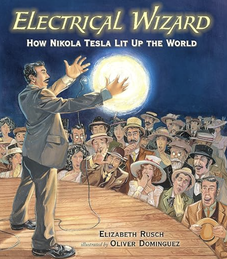
Electrical Wizard: How Nikola Tesla Lit Up The World. Elizabeth Rusch. Illustrated by Oliver Dominguez. Candlework, 2013. (4-6) Perseverance, Wonder, Diligence.
The intriguing story of the life of Nikola Tesla, whose interest in electricity was sparked when, as a young child in Serbia, he petted his cat and saw sparks coming from the cat's back. This book balances humanizing details like this with cogent scientific explanations of Tesla's discoveries and the advantages of AC over DC current, as well as his rivalry with Thomas Edison. Readers will thrill to the detailed descriptions of Tesla's inventions (could he harness the electrical power of Niagara Falls?) and be inspired to work toward their own discoveries. (As a note, the book includes a historically accurate but disturbing detail about Edison's smear campaign against Tesla—that it included publicly electrocuting animals.)
The intriguing story of the life of Nikola Tesla, whose interest in electricity was sparked when, as a young child in Serbia, he petted his cat and saw sparks coming from the cat's back. This book balances humanizing details like this with cogent scientific explanations of Tesla's discoveries and the advantages of AC over DC current, as well as his rivalry with Thomas Edison. Readers will thrill to the detailed descriptions of Tesla's inventions (could he harness the electrical power of Niagara Falls?) and be inspired to work toward their own discoveries. (As a note, the book includes a historically accurate but disturbing detail about Edison's smear campaign against Tesla—that it included publicly electrocuting animals.)
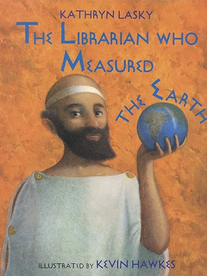
The Librarian Who Measured the Earth. Kathryn Lasky. Illustrated by Kevin Hawkes. Little, Brown Books, 2008. (3-6) Diligence, Imagination, Wonder.
The story of Eratosthenes, a librarian at the Library of Alexandria in the second-century BC. Using mathematical methods explained clearly in the book, Eratosthenes calculated the circumference of the earth—to a figure that we now know was within 200 miles of correct! With vivid illustrations, the book presents Eratosthenes as a model of wonder and imagination, as well as hard intellectual work to achieve a goal.
The story of Eratosthenes, a librarian at the Library of Alexandria in the second-century BC. Using mathematical methods explained clearly in the book, Eratosthenes calculated the circumference of the earth—to a figure that we now know was within 200 miles of correct! With vivid illustrations, the book presents Eratosthenes as a model of wonder and imagination, as well as hard intellectual work to achieve a goal.
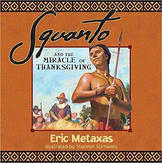
Squanto and the Miracle of Thanksgiving. Eric Metaxas. Illustrated by Shannon Stirnwels. Nelson,2012. (3-6)
A fascinating angle on the first Thanksgiving. In 1608, Tisquantum or “Squanto,” a Patuxet brave was abducted from his seaside village by European merchants and sold into slavery in Spain. His new masters were Spanish monks, who taught him their language and sympathized with his plight. More than a decade later, they arranged for his passage home to North America via London. There Squanto learned to speak English, and was treated well by the English. When he returned to his Massachusetts home, he found his village had been decimated by small pox, and a new colony of English living there. He felt called to help them. This is a rich narrative that tells the story of the first Thanksgiving through an unusual and very appropriate lens.
A fascinating angle on the first Thanksgiving. In 1608, Tisquantum or “Squanto,” a Patuxet brave was abducted from his seaside village by European merchants and sold into slavery in Spain. His new masters were Spanish monks, who taught him their language and sympathized with his plight. More than a decade later, they arranged for his passage home to North America via London. There Squanto learned to speak English, and was treated well by the English. When he returned to his Massachusetts home, he found his village had been decimated by small pox, and a new colony of English living there. He felt called to help them. This is a rich narrative that tells the story of the first Thanksgiving through an unusual and very appropriate lens.
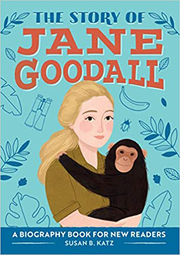
The Story of Jane Goodall. Susan B. Katz. Rockridge Press, 2020. (3-6) Stewardship, Lives to Learn From
This lively biography (62 pages) is amply illustrated, but narrates for older children the inspirational life of Jane Goodall. From the time when at age 6, Jane took a family of earthworms to bed with her, she had an unending love affair with nature. Curiosity and care combined as she embarked on her studies, which began in the fields of England, took her to Tanzania to work with the Leakeys, back to the University of Cambridge for her Ph.D., and ultimately to a life of vigil and study of primates in Africa. Goodall became a champion for the globe's chimpanzees. This wonderful, slender volume will inspire future generations in stewardship of the planet.
This lively biography (62 pages) is amply illustrated, but narrates for older children the inspirational life of Jane Goodall. From the time when at age 6, Jane took a family of earthworms to bed with her, she had an unending love affair with nature. Curiosity and care combined as she embarked on her studies, which began in the fields of England, took her to Tanzania to work with the Leakeys, back to the University of Cambridge for her Ph.D., and ultimately to a life of vigil and study of primates in Africa. Goodall became a champion for the globe's chimpanzees. This wonderful, slender volume will inspire future generations in stewardship of the planet.
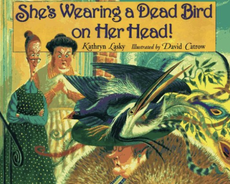
She's Wearing a Dead Bird on Her Head!. Kathryn Lasky. Illustrated by David Catrow. Disney-Hyperion, 1995. (3-6) Responsibility, Wonder, Stewardship, Lives to Learn From.
A fictionalized account of the two founders of the Massachusetts Audobon Society, Harriet Lawrence Hemenway and Minna B. Hall. In the 1890s Hemenway and Hall were society ladies, but were outraged when a new fashion emerged: wearing dead birds on hats. Their campaign to point out that this was ridiculous and cruel is vividly illustrated in this account, based on historical fact but with a note from the author to separate fact from fiction. Out of print, but accessible from libraries or secondary market.
A fictionalized account of the two founders of the Massachusetts Audobon Society, Harriet Lawrence Hemenway and Minna B. Hall. In the 1890s Hemenway and Hall were society ladies, but were outraged when a new fashion emerged: wearing dead birds on hats. Their campaign to point out that this was ridiculous and cruel is vividly illustrated in this account, based on historical fact but with a note from the author to separate fact from fiction. Out of print, but accessible from libraries or secondary market.
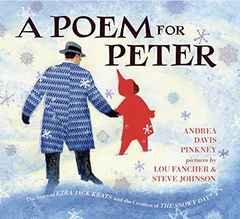
A Poem for Peter. Andrea Davis Pinkney. Illustrated by Steve Johnson.
Viking Books, 2016. (3-6) Wonder, Imagination, Immigrant Heritage Month.
The subtitle says it all: The Story of Ezra Jack Keats and the Creation of the Snowy Day. Delightful illustrations, reminiscent of the [earlier] classic children's book, grace [a] this biography of The Snowy Day’s author, Ezra Jack Keats. Keats himself was the son of Polish immigrants and grew up on New York's lower east side, with a heart for art and for the underdog. When he saw a photo of an African-American child in the snow (the great equalizing blanket), his heart was moved and the book, one of the first to feature a child of color (Peter), was born. The text, written in verse, is thought-provoking and
tells the story in a unique way.
Viking Books, 2016. (3-6) Wonder, Imagination, Immigrant Heritage Month.
The subtitle says it all: The Story of Ezra Jack Keats and the Creation of the Snowy Day. Delightful illustrations, reminiscent of the [earlier] classic children's book, grace [a] this biography of The Snowy Day’s author, Ezra Jack Keats. Keats himself was the son of Polish immigrants and grew up on New York's lower east side, with a heart for art and for the underdog. When he saw a photo of an African-American child in the snow (the great equalizing blanket), his heart was moved and the book, one of the first to feature a child of color (Peter), was born. The text, written in verse, is thought-provoking and
tells the story in a unique way.
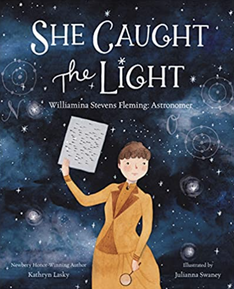
She Caught the Light. Kathryn Lasky. Illustrated by Julianna Swaney. HarperCollins, 2021. 3-6. Wonder, Diligence. The true story of the first American woman elected to honorary membership in the Royal Astronomical Society for her discovery of the Horsehead Nebula. From the time she was very young, Scottish-born Williamina Stevens Fleming (1857-1911) was curious and observant. She emigrated to America and became a maid in the home of Harvard astronomer, Edward Pickering, and kept asking her questions. Eventually Pickering (Director of the Harvard Observatory) realized that his maid had an aptitude for math and the study of stars. She hired her to replace one of his male assistants and she worked to catalog the spectra of stars recorded by the Observatory's telescope. She developed techniques of light analysis that helped her discover the composition of stars. As curator of Astronomical photographs, she was also the first woman to receive an official title from Harvard. Hard work, wonder, passion and perseverance combine in this book that will fascinate older elementary students.
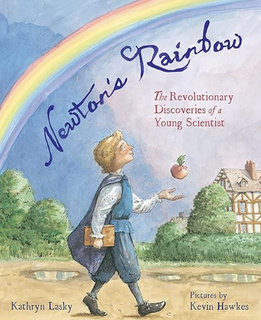
Newton's Rainbow: The Revolutionary Discoveries of a Young Scientist. Kathryn Lasky. Illustrated by Kevin Hawkes. Farrar, Straus and Giroux, 2017. (3-6) Diligence, Imagination, Wonder.
Kathryn Lasky brings her eye for historical detail and her narrative talents to the story of young Isaac Newton, who would eventually discover the law of gravity. A quiet child with a keen intellect, this book emphasizes young Newton's curiosity about the world around him, and the many scientific discoveries—including how rainbows work!—that arose from his curiosity and hard work. Some details about the bubonic plague, and text-heavy explanations of Newton's discoveries, make this book more suited for older readers.
Kathryn Lasky brings her eye for historical detail and her narrative talents to the story of young Isaac Newton, who would eventually discover the law of gravity. A quiet child with a keen intellect, this book emphasizes young Newton's curiosity about the world around him, and the many scientific discoveries—including how rainbows work!—that arose from his curiosity and hard work. Some details about the bubonic plague, and text-heavy explanations of Newton's discoveries, make this book more suited for older readers.
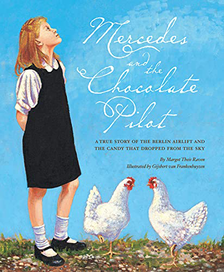
Mercedes and the Chocolate Pilot. Margaret Theis Raven.
Illustrated by Gijsbert van Frankenhuyzen. Sleeping Bear Press, 2002.
(3-6) Gratitude
At the beginning of the Cold War (1948), when Stalin’s Soviet Union attempted to starve out West Berlin, Allies rushed supplies by air to the city. One pilot, in particular, dropped candy in parachutes for the children. This is the touching true story of a German girl (Mercedes) who was unable to snag one of the bars in the competitive drop, but wrote to the pilot, and was rewarded with a box all her own and a letter from the pilot. The pilot (Gail Halvorsen) ended up returning to Berlin as Commander of the base thirty years later. Mercedes, a grown woman, invited him to dinner. Because of the complexity of the political background, this is an older children’s picture book, but it is heartwarming and a tear-jerker. Marvelous illustrations. Available on Epic!
Illustrated by Gijsbert van Frankenhuyzen. Sleeping Bear Press, 2002.
(3-6) Gratitude
At the beginning of the Cold War (1948), when Stalin’s Soviet Union attempted to starve out West Berlin, Allies rushed supplies by air to the city. One pilot, in particular, dropped candy in parachutes for the children. This is the touching true story of a German girl (Mercedes) who was unable to snag one of the bars in the competitive drop, but wrote to the pilot, and was rewarded with a box all her own and a letter from the pilot. The pilot (Gail Halvorsen) ended up returning to Berlin as Commander of the base thirty years later. Mercedes, a grown woman, invited him to dinner. Because of the complexity of the political background, this is an older children’s picture book, but it is heartwarming and a tear-jerker. Marvelous illustrations. Available on Epic!
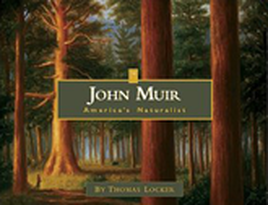
John Muir, America’s Naturalist. by Thomas Locker.
Fulcrum, 2010. (3-6) Gratitude,Wonder and Stewardship
Scottish born immigrant John Muir marveled at the beauty and bounty of the American West, where he studied nature, wrote about it, and worked to preserve it. Locker’s text and stunning illustrations showcase the Sierra Nevada region and the wonders of Yosemite. Muir insisted “No temple made with human hands can compare with Yosemite…the grandest of all special temples of nature.” He speculated on the Yosemite’s origin in glacial activity, pondered its botanical and geological features, and called for its preservation. This book inspires awe, wonder, and gratitude for both the gifts of nature and this industrious steward of natural wonders.
Fulcrum, 2010. (3-6) Gratitude,Wonder and Stewardship
Scottish born immigrant John Muir marveled at the beauty and bounty of the American West, where he studied nature, wrote about it, and worked to preserve it. Locker’s text and stunning illustrations showcase the Sierra Nevada region and the wonders of Yosemite. Muir insisted “No temple made with human hands can compare with Yosemite…the grandest of all special temples of nature.” He speculated on the Yosemite’s origin in glacial activity, pondered its botanical and geological features, and called for its preservation. This book inspires awe, wonder, and gratitude for both the gifts of nature and this industrious steward of natural wonders.
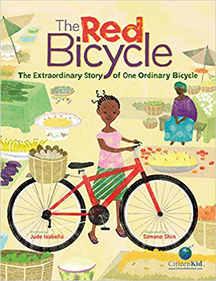
The Red Bicycle. The Extraordinary Story of One Ordinary Bicycle.
Jude Isabella. Illustrated by Simone Shin. Kids Can Press, 2015. (3-6) Stewardship, Responsibility
The inspiring true story of a bike that was loved by Leo in the United States, before he outgrew it. He donated it to a charity sending bikes to Burkina Faso in Africa. There the bike helps a family take their goods to market and their children to school. Later it is passed on to a clinic and used to transport ill patients. Rich text and lively illustrations, along with a useful Afterword of What You Can Do To Help.
Jude Isabella. Illustrated by Simone Shin. Kids Can Press, 2015. (3-6) Stewardship, Responsibility
The inspiring true story of a bike that was loved by Leo in the United States, before he outgrew it. He donated it to a charity sending bikes to Burkina Faso in Africa. There the bike helps a family take their goods to market and their children to school. Later it is passed on to a clinic and used to transport ill patients. Rich text and lively illustrations, along with a useful Afterword of What You Can Do To Help.
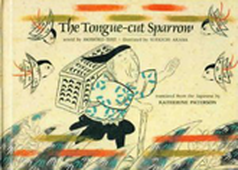
The Tongue-Cut Sparrow.* Katherine Paterson.
Illustrated by Suekichi Akaba. Dutton, 1987. (4-5) Gratitude
A Japanese folktale in which a sparrow teaches a mean-spirited old woman to appreciate the many gifts in her life. The poor, selfish, greedy old woman cannot be content. In a fit of anger she cuts out the tongue of her husband’s only treasure—a sweetly singing sparrow. The sparrow teaches her a lesson in living contentedly and humbly with what she has. *Available on Epic!
Illustrated by Suekichi Akaba. Dutton, 1987. (4-5) Gratitude
A Japanese folktale in which a sparrow teaches a mean-spirited old woman to appreciate the many gifts in her life. The poor, selfish, greedy old woman cannot be content. In a fit of anger she cuts out the tongue of her husband’s only treasure—a sweetly singing sparrow. The sparrow teaches her a lesson in living contentedly and humbly with what she has. *Available on Epic!
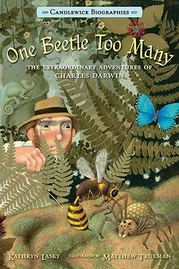
One Beetle Too Many: The Extraordinary Adventures of Charles Darwin. Kathryn Lasky. Illustrated by Matthew Trueman. Candlewick, 2014. (4-6) Wonder, Imagination, Lives to Learn From
Kathryn Lasky is queen of the older child's picture book and this work is no exception. Lively, illuminating text and striking illustrations bring Charles Darwin to life: his boundless curiosity as a child, fascination with collecting beetles and just about anything, a naturalist by leaning, though an easily bored student. His father disapproved of his professional choices, but Darwin followed his heart when he boarded the S. S. Beagle for the world-changing voyage that rendered the theory of evolution. Lasky's ability to distill complicated concepts into intelligible and conversational language distinguishes her work. The illustrations sing. A great older grade read-aloud.
Kathryn Lasky is queen of the older child's picture book and this work is no exception. Lively, illuminating text and striking illustrations bring Charles Darwin to life: his boundless curiosity as a child, fascination with collecting beetles and just about anything, a naturalist by leaning, though an easily bored student. His father disapproved of his professional choices, but Darwin followed his heart when he boarded the S. S. Beagle for the world-changing voyage that rendered the theory of evolution. Lasky's ability to distill complicated concepts into intelligible and conversational language distinguishes her work. The illustrations sing. A great older grade read-aloud.
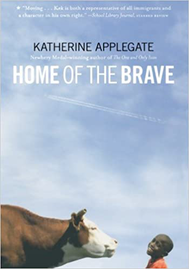
Home of the Brave. Katherine Applegate. Square Fish, 2008. (5-6) Hope, Gratitude, Courage. 272 pages
This story is not to be missed: you will laugh, cry, and shout for joy with Kek, a ten-year-old boy who, fleeing violence in his African homeland (Sudan), and has settled (with aunt and cousin) in Minnesota. Kek is an optimist, who earnestly strives to embrace his new life, and is quick to see goodness. In Minnesota, he experiences the joy and hardship of winter (moon-shaped snowballs but bone-chilling cold), of school (a chair and desk of his own, but sometimes classmates who mock him), of technology (machines that wash clothes and dishes, but do not forgive if he puts dishes in the wrong one). He is often overcome with wonder at the "honors" that come to him for free. But he is haunted by the memories of violence that took his father and brother, and the uncertainty of ever seeing his mother again. Is she even alive? Then there is the nagging question of whether America will ever be home for him. His friendships (with Hannah, a girl in foster care and Lou, an older woman who runs a farm) and ingenious schemes to better his life and the lives of those around him will win your heart. (Spoiler alert: Mom is alive and joins him at the end.) It is a book of hope, gratitude, and great courage shown on the part of one so young, as by many immigrants over the years. Despite its length, it is written in free verse with wide margins. A riveting read-aloud over 5-7 sessions for older children.
This story is not to be missed: you will laugh, cry, and shout for joy with Kek, a ten-year-old boy who, fleeing violence in his African homeland (Sudan), and has settled (with aunt and cousin) in Minnesota. Kek is an optimist, who earnestly strives to embrace his new life, and is quick to see goodness. In Minnesota, he experiences the joy and hardship of winter (moon-shaped snowballs but bone-chilling cold), of school (a chair and desk of his own, but sometimes classmates who mock him), of technology (machines that wash clothes and dishes, but do not forgive if he puts dishes in the wrong one). He is often overcome with wonder at the "honors" that come to him for free. But he is haunted by the memories of violence that took his father and brother, and the uncertainty of ever seeing his mother again. Is she even alive? Then there is the nagging question of whether America will ever be home for him. His friendships (with Hannah, a girl in foster care and Lou, an older woman who runs a farm) and ingenious schemes to better his life and the lives of those around him will win your heart. (Spoiler alert: Mom is alive and joins him at the end.) It is a book of hope, gratitude, and great courage shown on the part of one so young, as by many immigrants over the years. Despite its length, it is written in free verse with wide margins. A riveting read-aloud over 5-7 sessions for older children.
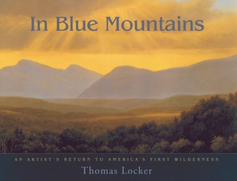
In Blue Mountains. An Artist's Return to America's First Wilderness. Thomas Locker. Bell Pond Books, 2000. (4-8) Wonder, Beauty, Awe
Artist Thomas Locker paints in the style of the Hudson River School, and this gorgeous volume explains how at a time of trial, he immersed himself in the Catskill Mountains on a "vision quest." His encounter with the beauty, light, and majesty of nature is accompanied by paintings that will take your breath away. It is a tribute to nature and to the artistic epiphanies that allow painters to render its glory. Truly wonder-ful.
Artist Thomas Locker paints in the style of the Hudson River School, and this gorgeous volume explains how at a time of trial, he immersed himself in the Catskill Mountains on a "vision quest." His encounter with the beauty, light, and majesty of nature is accompanied by paintings that will take your breath away. It is a tribute to nature and to the artistic epiphanies that allow painters to render its glory. Truly wonder-ful.
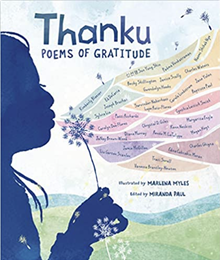
Thanku: Poems of Gratitude. Miranda Paul, ed. Illustrated by Marlena Myles. Millbrook Press, 2019.
This anthology of poems from a diverse group of authors teaches children about poetry (various poetic forms from sonnet to quatrain to sijo) while lifting hearts to thankfulness for the things of daily life. Beautifully illustrated.
This anthology of poems from a diverse group of authors teaches children about poetry (various poetic forms from sonnet to quatrain to sijo) while lifting hearts to thankfulness for the things of daily life. Beautifully illustrated.
|
Parent/Teacher Recommendations
for Gratitude and Stewardship: 
For an awe-inspiring reflection on making your day "A Grateful Day" watch this beautiful video by Brother David Steindl-Rast.
Gratitude
We recommend two works by psychologist Robert Emmons, whose trail-blazing work on the "science of gratitude" gives ancient virtue a thumbs-up from modern psychology. Check out Thanks! How the New Science of Gratitude Can Make You Happier (Houghton Mifflin, 2007) and his more recent book, Gratitude Works! A 21-Day Program for Creating Emotional Prosperity (Jossey-Bass, 2013). Both are gems, and these books will inspire hands-on ideas for teachers: for example, have students keep a gratitude journal in the month of November, writing down five things each day for which they are grateful. The possibilities are endless. |

Stewardship
One of the most articulate expressions of the need to be faithful in the little things comes from Navy Admiral William H. McRaven, whose 2017 Commencement Address, “Make Your Bed: Little Things That Can Change Your Life and Maybe Save the World” went viral. Now in print, we grown-ups can learn lots from this former Navy SEAL. “If you want to change the world, start off by making your bed.”
One of the most articulate expressions of the need to be faithful in the little things comes from Navy Admiral William H. McRaven, whose 2017 Commencement Address, “Make Your Bed: Little Things That Can Change Your Life and Maybe Save the World” went viral. Now in print, we grown-ups can learn lots from this former Navy SEAL. “If you want to change the world, start off by making your bed.”
For an extensive bibliography of quality children's literature exemplifying these virtues,
see the Core Virtues Resource Guide.
Additional suggestions by virtue for K-3 ; Additional suggestions for 3-6
see the Core Virtues Resource Guide.
Additional suggestions by virtue for K-3 ; Additional suggestions for 3-6
